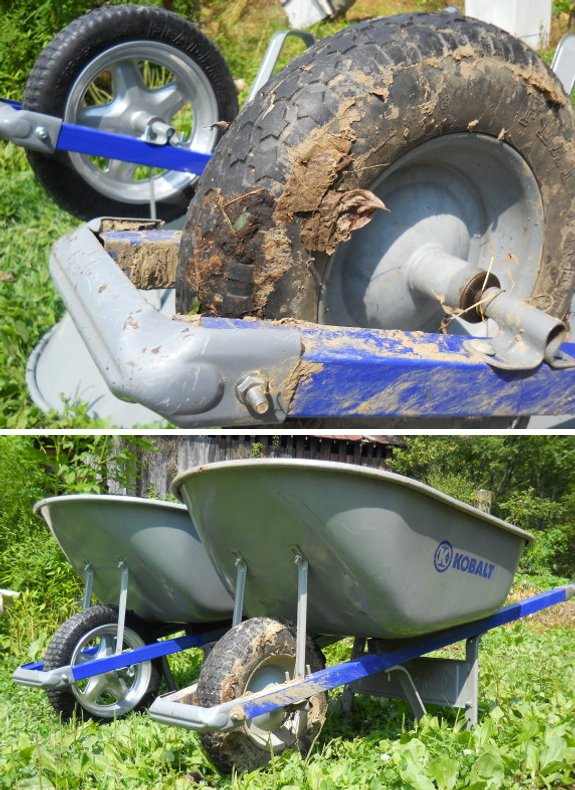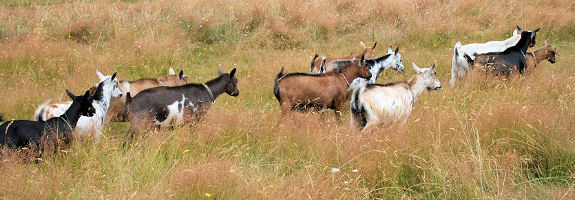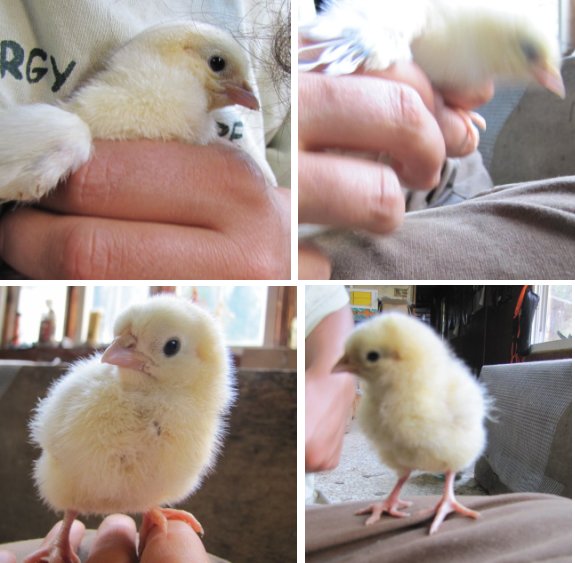
archives for 08/2011
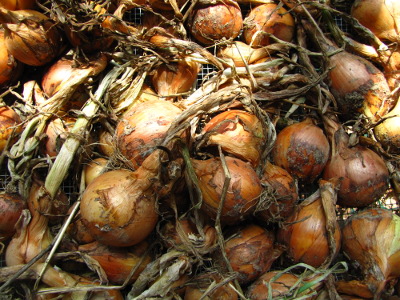 I'm
bound and determined to grow
our onions from seed rather than sets
because it costs much less and the onions will store through the winter
rather than giving up the ghost in late fall. One year, I had a
beautiful harvest from seed, but the next two years I got just a
few small onions. So this spring, I decided to try out several
different methods to figure out the simplest way to grow onions
effectively from seed.
I'm
bound and determined to grow
our onions from seed rather than sets
because it costs much less and the onions will store through the winter
rather than giving up the ghost in late fall. One year, I had a
beautiful harvest from seed, but the next two years I got just a
few small onions. So this spring, I decided to try out several
different methods to figure out the simplest way to grow onions
effectively from seed.
Here are the six
"treatments" I used in my 2011 onion experiment:
- 1. Early start with biochar under a quick hoop --- Direct-seeded on February 18 into soil treated with biochar under a quick hoop
- 2. Early start under a quick hoop
--- Just like above, but no biochar
- 3. Transplant into quick hoop
late --- Started indoors in February, then transplanted into a
quick hoop on March 8
- 4. Transplant into bare soil late
--- Same as above, but transplanted into soil not covered by a quick
hoop
- 5. Direct seeded into quick hoop
late --- Started directly under a quick hoop on March 8
- 6. Direct seeded into bare soil late --- Started directly into bare soil on March 8
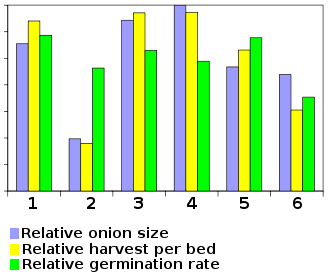 It
looks like the pros who tell you to start your onions inside and then
transplant them are right since treatments 3 and 4 are the clear
winners. (It doesn't seem to matter whether you transplant into a
quick hoop or not.) However, I was interested to see that if
you're lazy and don't like starting seeds inside, you can get results
nearly as good by direct-seeding into biochar-doctored soil under a
quick hoop at the same time you would have started your onions
inside.
My sample size for that treatment was extremely small (half of a bed),
so I'd hate to have anyone plan their entire year's onion harvest
around that observation, but it's definitely worth further
experimentation.
It
looks like the pros who tell you to start your onions inside and then
transplant them are right since treatments 3 and 4 are the clear
winners. (It doesn't seem to matter whether you transplant into a
quick hoop or not.) However, I was interested to see that if
you're lazy and don't like starting seeds inside, you can get results
nearly as good by direct-seeding into biochar-doctored soil under a
quick hoop at the same time you would have started your onions
inside.
My sample size for that treatment was extremely small (half of a bed),
so I'd hate to have anyone plan their entire year's onion harvest
around that observation, but it's definitely worth further
experimentation.
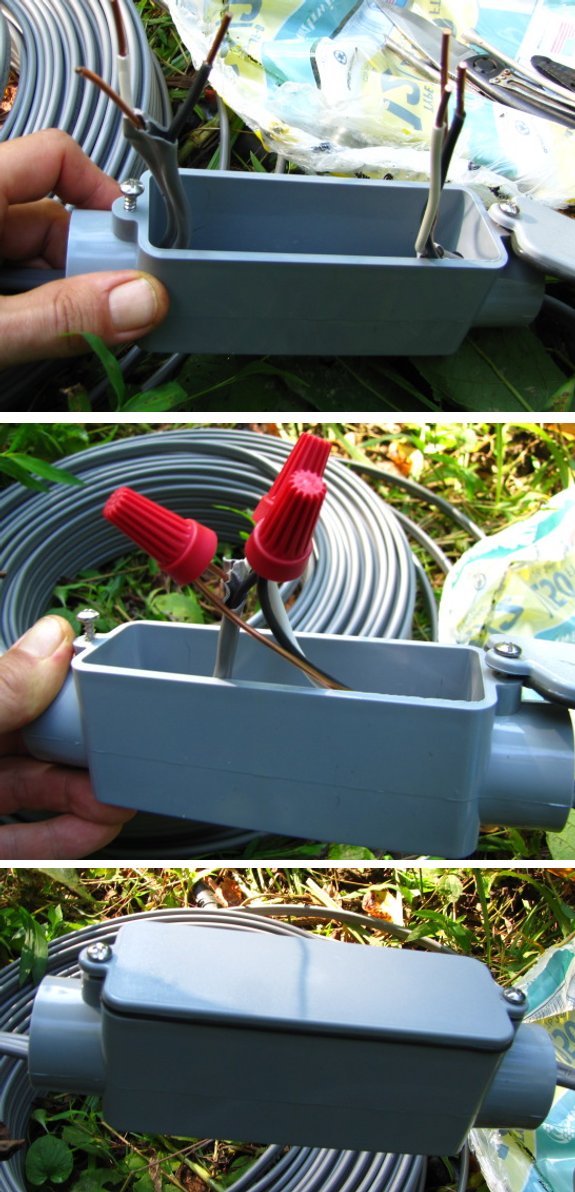
We've been having some
trouble with our
creek pump and the first
place we decided to upgrade was the quality of the wiring.
You can get a 250 foot roll
of outdoor grade 12 gauge 2 wire for around 138 dollars. Our stretch is
just over 300 feet, which required the above 4 dollar junction box.
The plan will be to silicone
up the ends and mount it on a tree above the point where the flood
waters usually get.
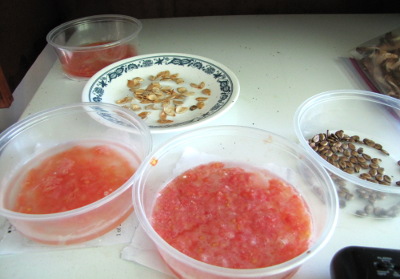 As I slowly work my way
beyond the seed-saving
basics, I'm starting
to realize that saving the seeds from the lone kale plant that
overwintered in my garden might not be a good idea. To understand
how many individuals you need to save healthy seeds, first you have to
delve into a bit of pollination biology.
As I slowly work my way
beyond the seed-saving
basics, I'm starting
to realize that saving the seeds from the lone kale plant that
overwintered in my garden might not be a good idea. To understand
how many individuals you need to save healthy seeds, first you have to
delve into a bit of pollination biology.
All plants fit somewhere
on the spectrum between strong inbreeders and strong outbreeders.
At the far inbreeding extreme lie plants like
tomato-leaved tomatoes, peas, and green beans, all of which have
flowers that make it extremely unlikely that an insect can get inside
to move pollen from one plant to another. These vegetables breed
with themselves as a matter of course, so they've worked the bad
recessive traits out of their populations. The pros recommend
saving seeds from at least 20 plants for strong inbreeder species, but
at the backyard scale, you can get away with just a few parent plants
(or sometimes even one.)
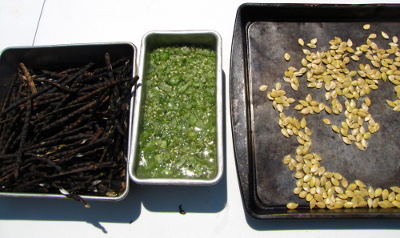 At
the opposite end of the spectrum, strong outbreeders (like most crucifers, swiss
chard, spinach, and beets) depend on getting pollen from another plant
to keep those recessive genes in check. You'll need around 80 to
100 individuals of these species in your garden to keep your seed
vigorous. If you save seeds from just a few individuals, next
year's plants will tend to be weaker and you'll eventually need to buy
seeds to reset your gene pool.
At
the opposite end of the spectrum, strong outbreeders (like most crucifers, swiss
chard, spinach, and beets) depend on getting pollen from another plant
to keep those recessive genes in check. You'll need around 80 to
100 individuals of these species in your garden to keep your seed
vigorous. If you save seeds from just a few individuals, next
year's plants will tend to be weaker and you'll eventually need to buy
seeds to reset your gene pool.
Most plants, of course,
lie somewhere in the middle, and there are also outbreeders (like most
cucurbits) that don't seem to show many problems even if you inbreed
them. You can download a free pdf
here that gives
recommended population sizes for most common vegetables. (The
website asks for your email address before download, but they haven't
sent me any spam. The file you want is A Seed
Saving Guide for Gardeners and Farmers.) Alternatively, if
you want to become a real seed-saving pro, I can't recommend Seed to Seed by Suzanne Ashworth highly
enough. This text made the very short list of book purchases in
our household for 2012 and has turned my dabbling in seed-saving into a
scientific endeavor.
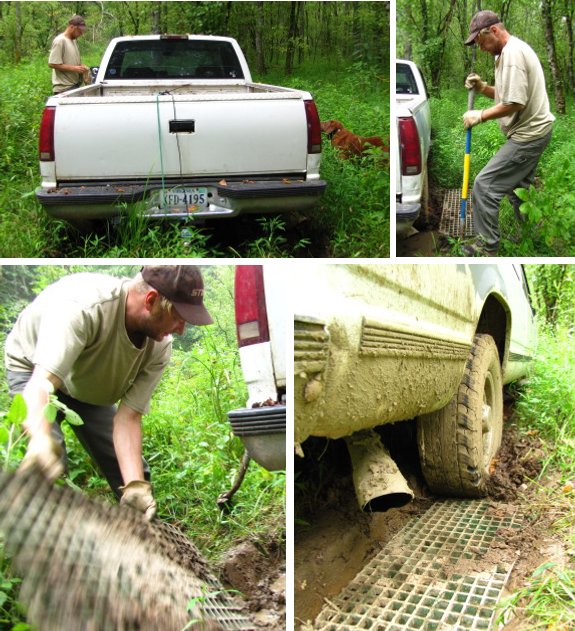
It has been a very wet year.
The truck has been stuck most
of the summer.
Today we got close to getting
it on its way....but it's still stuck.
Maybe tomorrow will be dry
enough?
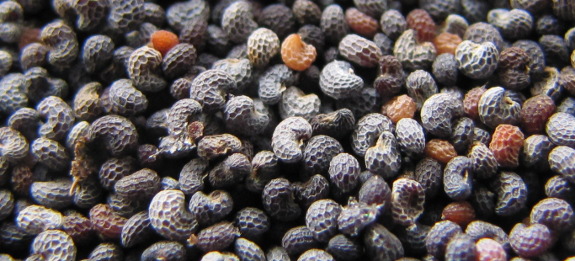
Although breadseed
poppies and opium poppies are in the same species and look very
similar, it's legal
to grow your own poppy seeds. Many websites will
tell you otherwise, though, so I was afraid to try my hand until I
found culinary poppy seeds being sold by a reputable seed company.
Growing poppies is
pretty simple, but I've learned a few tricks over the last couple of
years to increase yields. Unlike most ornamental poppies,
breadseed poppies aren't hardy enough to be seeded in the fall here in
zone 6, so you should instead scatter
the tiny seeds lightly on the soil surface in late February. If you live in a
warmer climate, you might get away with seeding in late autumn.
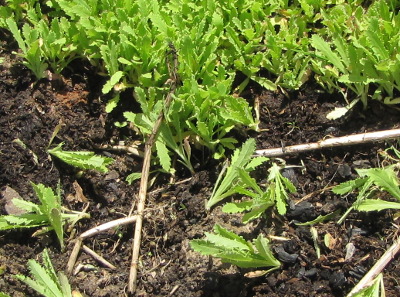 In 2010, I
sowed my seeds too far apart, so this year I planted more
heavily with the result that the seedlings formed a solid mass of green
across the bed by late April. That seems to have been overkill
--- fewer poppy seeds came up on a different bed, and these better
spaced seedlings resulted in much larger pods. I suspect that the
optimal distance between plants would be about four inches in a highly productive,
no-till garden, although extension service websites suggest 6 to 8 inch
spacing in a more conventional garden. If you're going to
overplant and thin, remove the extra seedlings by March or early April
--- I thinned later than I should have in the photo above.
In 2010, I
sowed my seeds too far apart, so this year I planted more
heavily with the result that the seedlings formed a solid mass of green
across the bed by late April. That seems to have been overkill
--- fewer poppy seeds came up on a different bed, and these better
spaced seedlings resulted in much larger pods. I suspect that the
optimal distance between plants would be about four inches in a highly productive,
no-till garden, although extension service websites suggest 6 to 8 inch
spacing in a more conventional garden. If you're going to
overplant and thin, remove the extra seedlings by March or early April
--- I thinned later than I should have in the photo above.
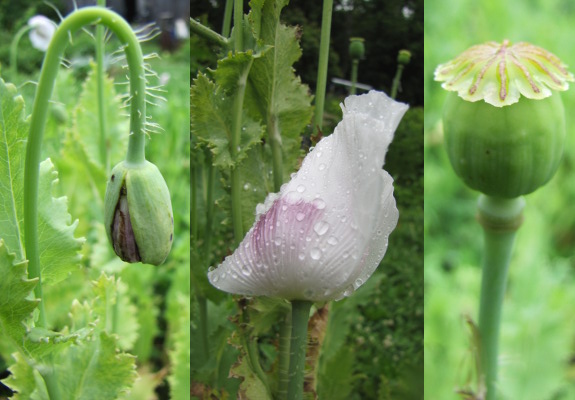
Your breadseed poppies
will be in full bloom in June, and your honeybees will love them.
Besides keeping the plants weeded, you don't have to do anything now
until the pods bulk up and then turn brown. At that point, snip off
the seed heads and bring them inside to dry.
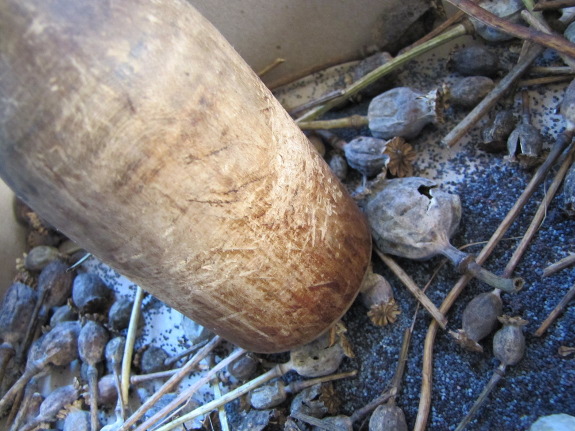
Once the poppy heads are
entirely dry, tiny holes near the top of the pod will open, so it's
technically feasible to shake mature pods in a paper bag until all of
the seeds fall out. In practice, though, it's much more efficient
to pound the
pods to crush them, tear the heads open a little more with your
fingers, and then shake out the seeds from one pod at a time. This really doesn't
take very long if you've just grown a small patch of poppies.
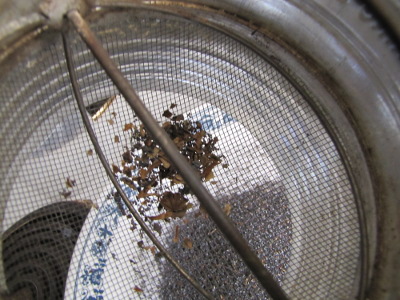 Poppy seeds are too small to
winnow easily in front of a fan, but you can remove
nearly all of the bits of chaff by sending the seeds through a sifter. Let the seeds dry a
bit more in an open container, then seal them away for winter
treats. I've discovered that if I paint raw egg on the top of
homemade buns before their last rise, sprinkle on breadseed poppies,
then mash the seeds into the dough with the palm of my hand, nearly all
of the precious seeds stay in place and the plain old bread turns into
a treat. I figure this year's quarter cup harvest will last all
winter.
Poppy seeds are too small to
winnow easily in front of a fan, but you can remove
nearly all of the bits of chaff by sending the seeds through a sifter. Let the seeds dry a
bit more in an open container, then seal them away for winter
treats. I've discovered that if I paint raw egg on the top of
homemade buns before their last rise, sprinkle on breadseed poppies,
then mash the seeds into the dough with the palm of my hand, nearly all
of the precious seeds stay in place and the plain old bread turns into
a treat. I figure this year's quarter cup harvest will last all
winter.
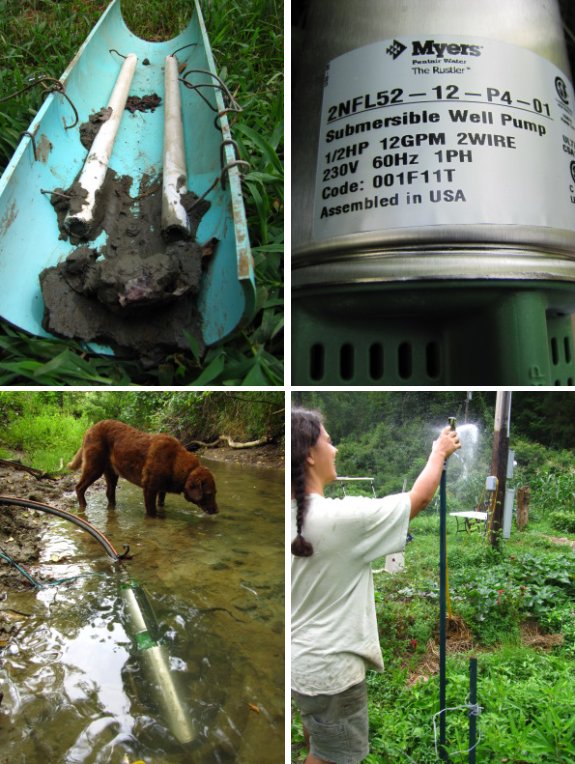
We figured out the problem
was not with the wiring. I'm still glad we upgraded
to the 12 gauge wire,
which might help our new pump last longer.
The PVC
pipe I cut in half to hold the pump turned out to be a mistake. It
was allowing clay to accumulate next to the motor, which might have
been causing it to overheat and then to shut down. We deleted that
"improvement" today.
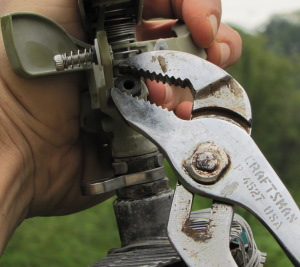 Another mistake might have been
upgrading the power from 1/2 horsepower to 3/4. We decided to take back
the 3/4 horsepower pump to Lowes and order a 1/2 horsepower pump from
our local hardware store. The new pump is made by Myers, and the step
down in power cost more than the Lowes 3/4 pump by about 50 dollars,
which I feel fine about. I'm confident our local guy is not gouging us
on the price and think that this may be a higher quality device.
Another mistake might have been
upgrading the power from 1/2 horsepower to 3/4. We decided to take back
the 3/4 horsepower pump to Lowes and order a 1/2 horsepower pump from
our local hardware store. The new pump is made by Myers, and the step
down in power cost more than the Lowes 3/4 pump by about 50 dollars,
which I feel fine about. I'm confident our local guy is not gouging us
on the price and think that this may be a higher quality device.
It sure is nice to not have a
garden full of thirsty vegetables.
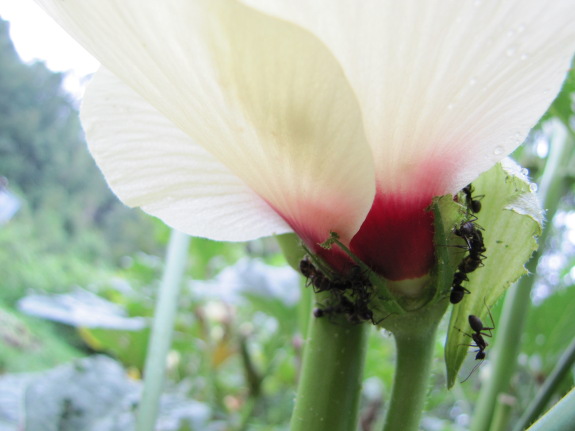
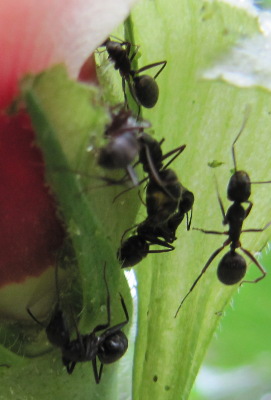 The
bases of our okra flowers are currently loaded down with big, black
ants. What the insects are doing is beyond me.
The
bases of our okra flowers are currently loaded down with big, black
ants. What the insects are doing is beyond me.
My first thought was
that okra must be one of the plants with extrafloral nectaries, but a
google search turns up no useful hits on the combo of terms.
Instead, I learned that
fire ants will often feed on the base of okra bloom buds and cause the
flowers to abort. Luckily, these are neither fire ants nor bloom
buds, and my fruits seem to be setting fine.
A close look shows that
the ants aren't farming
aphids --- the other
way ants could harm okra. So what are they doing?
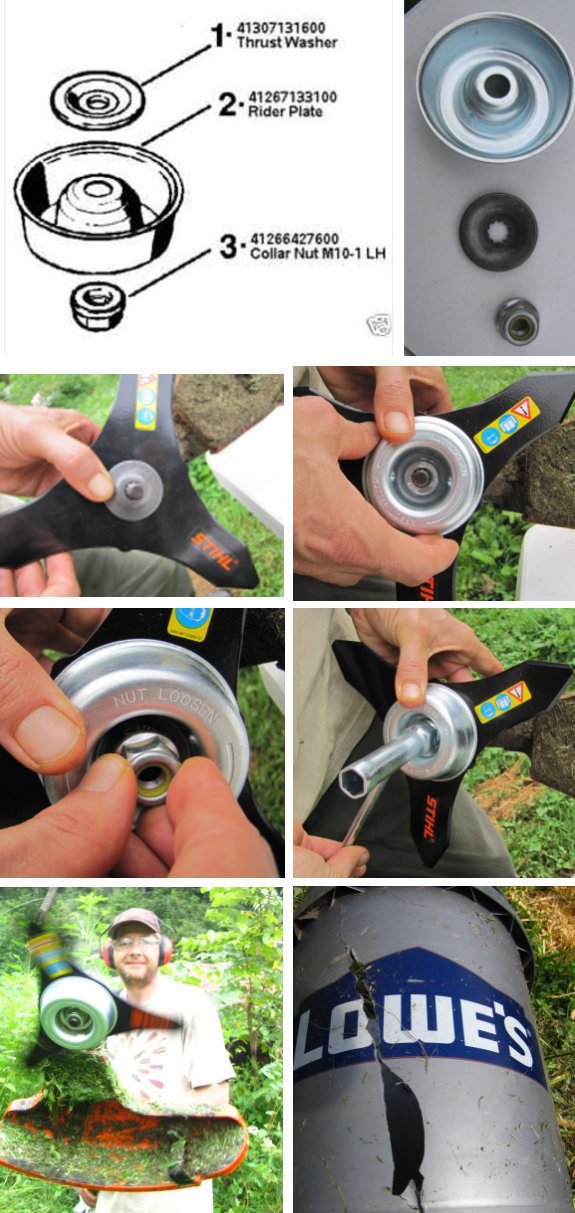
We bought a heavy duty
cutting blade for the new Stihl
FS-90R weedeater a few
weeks ago, but didn't read the small print and missed out on the collar
nut-thrust washer kit, which is mandatory if you want the blade to stay
bolted to the machine.
A 2 minute search on Ebay
turned up a nice guy who sells the kit for a bit over 10 dollars.
I'm very pleased with the
performance and cutting power. We let some of the forest
garden weeds get so high
that most of them were over my head. It only took a matter of minutes
to cut them down to ankle height.
Maybe next year we can cut
them before they get high enough to swallow 5 gallon buckets, which are
no match for what I've started calling the "Ninja Blade".

It's
tough to think long term when you're struggling to keep your short term
affairs in order. That could mean not putting money in your
retirement account because you can barely pay the bills. Or, in
the Walden Effect world, it could mean neglecting your perennials
because the annual garden is all you can handle.
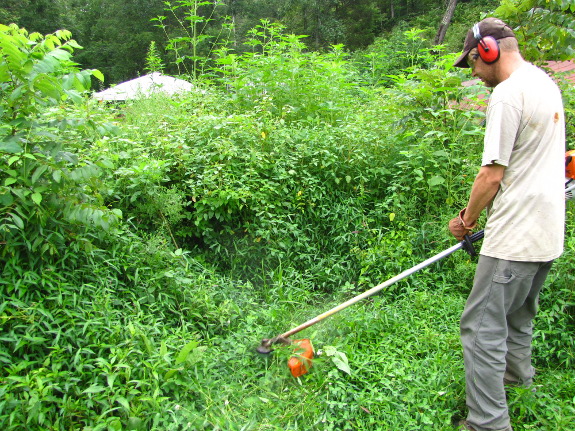
The photo at the top of
this post shows our poor forest garden,
untouched since I halfway mulched a few areas in the winter.
Somewhere deep in that tangle, two baby apple trees, a baby peach, a
medium-sized nectarine, a plum, and a young hazel bush are hiding,
along with four tomato
plants, some perennial herbs, and a whole bunch of butternuts and
naked-seed
pumpkins. Okay, the last two aren't really hiding --- as annuals,
I gave them attention, so they are happily mulched, although starting
to run into the weeds.
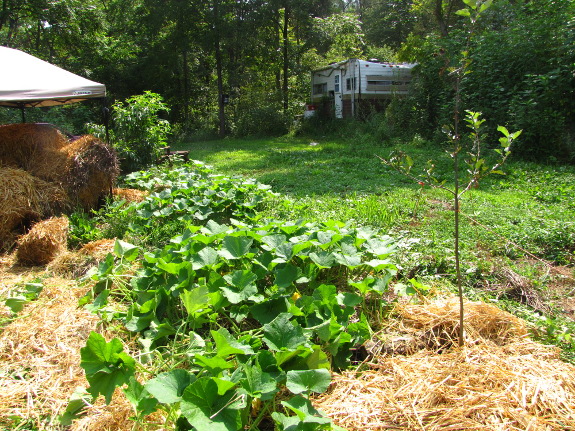
The problem with this
area is that the mower can't get into it easily,
due to various experiments on my part combined with the remnants of a
brush pile. In southwest Virginia, unchecked weeds can grow
nearly twenty feet tall in just a few months --- and that's the annuals
that start from seed each spring. Enter Mark's
ninja
blade, combined with
my hand-weeding, mulching, and directing. ("No, don't cut
there! That's a tree! Cut this area again, lower!")
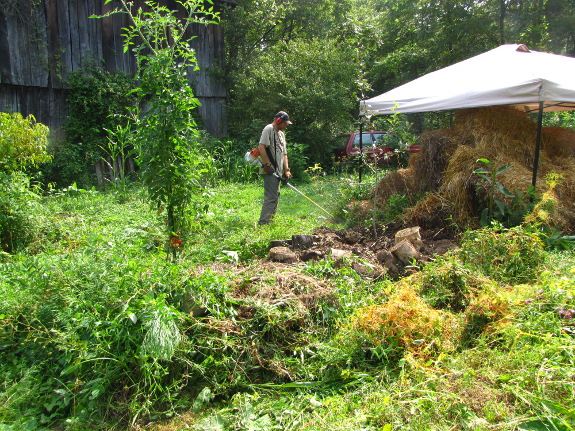
Four and a half man
hours later, the worst half of the forest garden has been
reclaimed. Now our seedling fruit trees won't have to compete
with ragweed taller than they are, with dodder sucking out their juices,
and with a general lack of love. Plus, I can delete the constant
low-level stress of worrying about the forest garden's inhabitants.
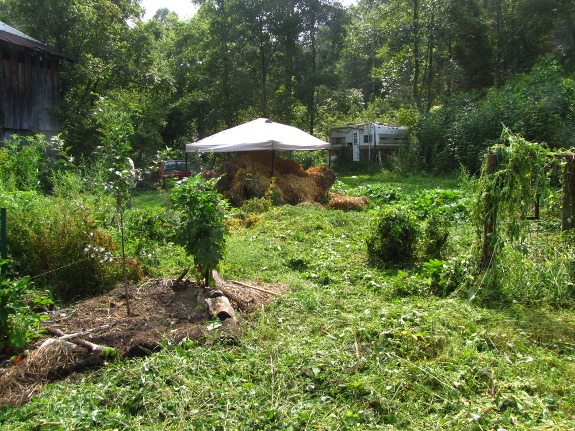
In retrospect, the one
thing I did right in the forest garden this year was planting
four tomatoes amid the trees. We love tomatoes so much that I
wasn't willing to risk any of the harvest, which is what finally pushed
me over the edge to putting forest garden renovation on the list.
Maybe that's a bit like setting up automatic, monthly direct deposits
into your retirement account?
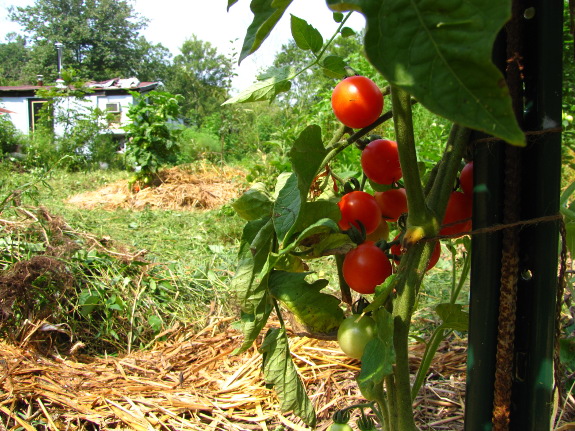
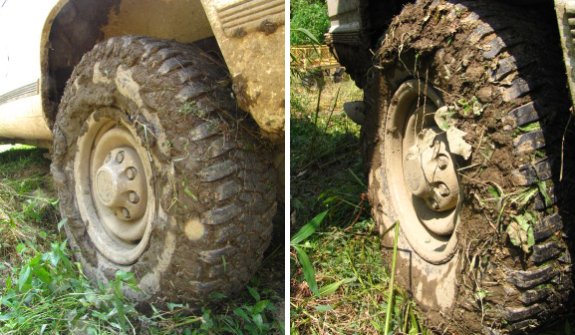
A big thanks goes out to
Roland's scientific comment on my Tuesday post concerning our muddy
driveway and truck traction.
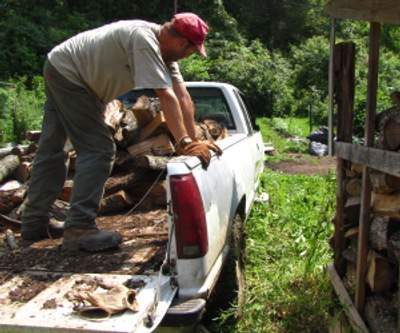
It helped in convincing Anna
that upgrading the back tires might increase traction without doing
further damage to the flood plain.
We got the truck free just
before sunset yesterday, and woke up early to visit our local tire
store and manure pile.
The next size up in tire and
traction cost us about 180 dollars. What also helped was moving the old
back tires to the front. This will help control the steering more,
which I think was a factor in driving out of the rut the last time it
got stuck.
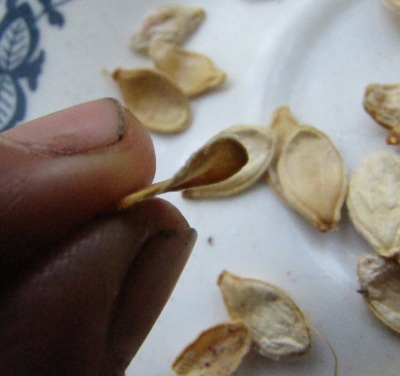 I thought I was so clever
scooping seeds out of my monster
squash to save for
next year's garden. But once I rinsed the seeds off and let them
dry, it became evident that the flat, shriveled seeds weren't going to
be viable. What did I do wrong?
I thought I was so clever
scooping seeds out of my monster
squash to save for
next year's garden. But once I rinsed the seeds off and let them
dry, it became evident that the flat, shriveled seeds weren't going to
be viable. What did I do wrong?
Further research turned
up the information that I was skipping a step in my seed-saving
endeavor. First, I should have waited until the monster squash
was mature enough that I couldn't dent the skin with my fingernail
(which I discovered on my second try resulted in a more orange-colored
and warty fruit.) Next, remove the mature squash from the vine
and let it sit for two weeks before crushing the fruit under your heel
and scooping out the innards.
If you've done
everything right, the center of your summer squash should actually look
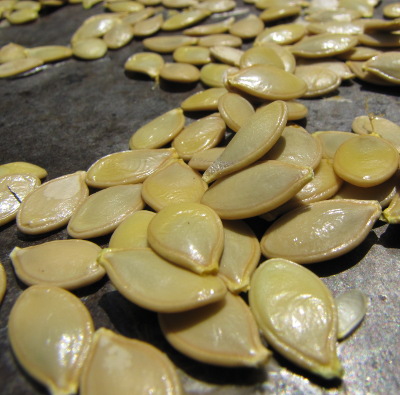 like
the inside of a pumpkin or other winter squash. The seeds will be
mixed in with strands of moist flesh, and there will be a significant
amount of air space. As you pull out the seeds, the squash guts
will smell just like the hollowed out center of your jack-o-lantern.
like
the inside of a pumpkin or other winter squash. The seeds will be
mixed in with strands of moist flesh, and there will be a significant
amount of air space. As you pull out the seeds, the squash guts
will smell just like the hollowed out center of your jack-o-lantern.
After rinsing my second
round of squash seeds and pouring off any that floated in water, I
ended up with the plump seeds shown here. Success at last!
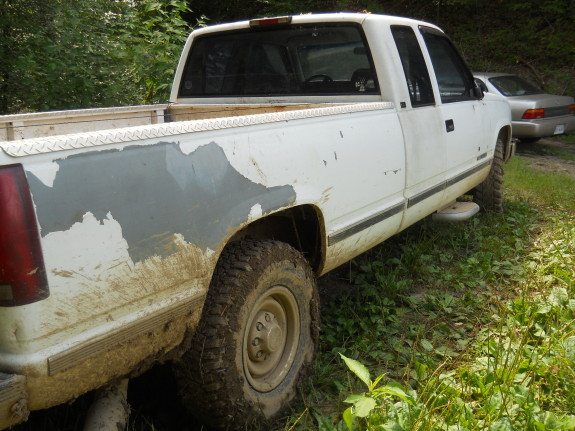
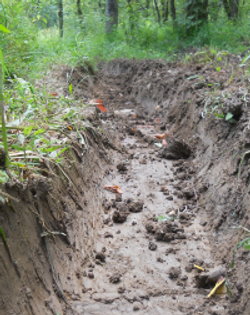
The above picture of our
truck being parked in its designated spot represents a small victory
for us.
It's a hard thing to gauge,
but if I had to guess I would say the new
tires are giving us a 30 percent increase in traction and steering
control.
We've been able to haul in
some much needed manure, a load of firewood, and a new futon couch
during what must be our driest stretch of 2011 so far this year.
The next step will be to pick
up a load of big gravel to fill in some of the troubled spots...that is
if the rain can hold off for another few days.
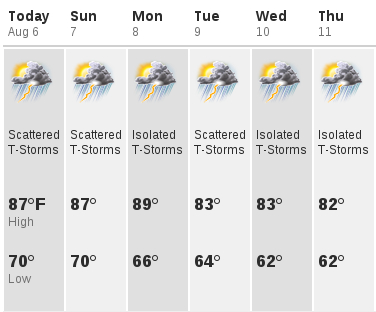 The ten day weather forecast
is
often what spurs us on to crazy exploits. Realizing that Friday
was our lone day of sun before the rain set back in, Mark donned his
work clothes at 8:30 Thursday evening and rocked the
truck out of what
remained of the mud.
Twelve hours later, he was in town replacing
the tires and then shoveling masses of horse manure into the truck's
bed.
The ten day weather forecast
is
often what spurs us on to crazy exploits. Realizing that Friday
was our lone day of sun before the rain set back in, Mark donned his
work clothes at 8:30 Thursday evening and rocked the
truck out of what
remained of the mud.
Twelve hours later, he was in town replacing
the tires and then shoveling masses of horse manure into the truck's
bed.
Meanwhile, I stayed home
to see what I could do about scavenging some
bricks from the old house's chimney and collecting bits of discarded
rip-rap to toss in the most muddy 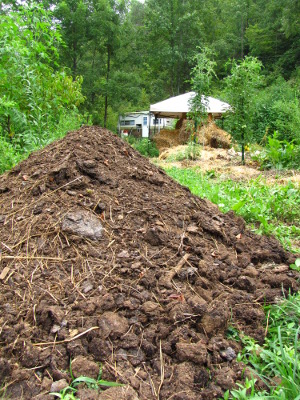 part
of the driveway. Then I
rearranged the woodpile to put all of last year's wood in the front and
cleared a path so the truck could be driven around to the back.
part
of the driveway. Then I
rearranged the woodpile to put all of last year's wood in the front and
cleared a path so the truck could be driven around to the back.
Finally, I cooled down
from what was already
turning out to be a
scorcher. You see, I had a crazy, over-ambitious plan of not only
unloading the horse manure, but also hauling in the load of firewood
we'd had delivered to the other side of the creek, and I figured that
if Mark and I tag-teamed our mandatory cool-down periods, we could get
twice as much work done. So, in a rare show of housewifery, I met
him at the door with his AC running on high and a cup of ice water and
cold watermelon in my hand. He ate that (and his lunch) while I
unloaded the manure --- so much easier to shovel it out of a truck than
in.
The day had taken on a
dream-like quality by the time the two of us
heaved huge slabs of wood into a towering pile in the truck. We
filled the cab with chicken waterer 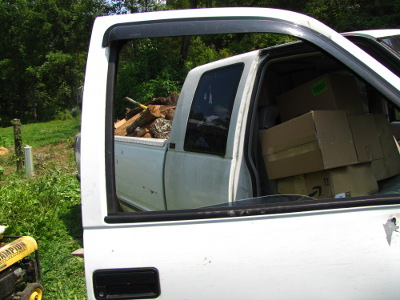 supplies
that had also been piling
up in the parking area and I walked home while Mark and the truck did
the work of about 100 people by transporting goods the third of a mile
to our trailer.
supplies
that had also been piling
up in the parking area and I walked home while Mark and the truck did
the work of about 100 people by transporting goods the third of a mile
to our trailer.
I made Mark go cool down
again while I unloaded the light boxes.
This was clearly a mistake --- I seem to know Mark's limitations better
than my own, and the afternoon sun was pounding on my hatted head
despite the lightness of my burden. By that evening, I would be
suffering from the early stages of heat exhaustion --- a pounding
headache, clammy skin, and nausea. But at the time I was running
on adrenaline --- look at all this biomass driven right to our doorstep!
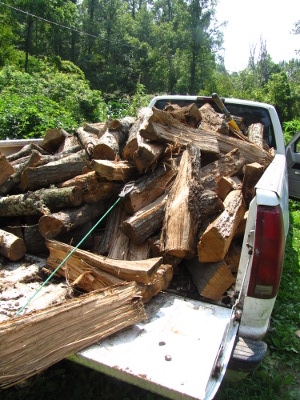 Luckily, Mark thought the
suggestion that I unload the firewood by
myself was nuts, so he handed me wood off the truck while I obsessively
stacked it into neat rows, segregated from last year's bone dry wood
which we'll use first. I'm always amazed by the power of
teamwork, which in this case meant
that we unloaded the truck in
perhaps thirty minutes flat.
Luckily, Mark thought the
suggestion that I unload the firewood by
myself was nuts, so he handed me wood off the truck while I obsessively
stacked it into neat rows, segregated from last year's bone dry wood
which we'll use first. I'm always amazed by the power of
teamwork, which in this case meant
that we unloaded the truck in
perhaps thirty minutes flat.
"So, I was thinking," I
tentatively broached the subject of yet more
hauling. "I know you've been eying that futon..." Mark's
room was devoid of furniture save a bed, and he'd been wanting a futon
for months. There was no point in buying any furniture, though,
when we had no way of bringing it home. Maybe this was our
chance, if we could survive a few more hours driving to town?
Mark was game.
And that's how we ended
our Friday at 8:30 pm,
a truckload of manure, a truckload of wood, and a futon (and
wheelbarrrow) richer. I went to bed shortly thereafter with ice
on my head, but it was all worth it. Mental note --- when I
complain about us starting work late on dark winter mornings, I need to
remember the twelve hour summer days that preceded them.
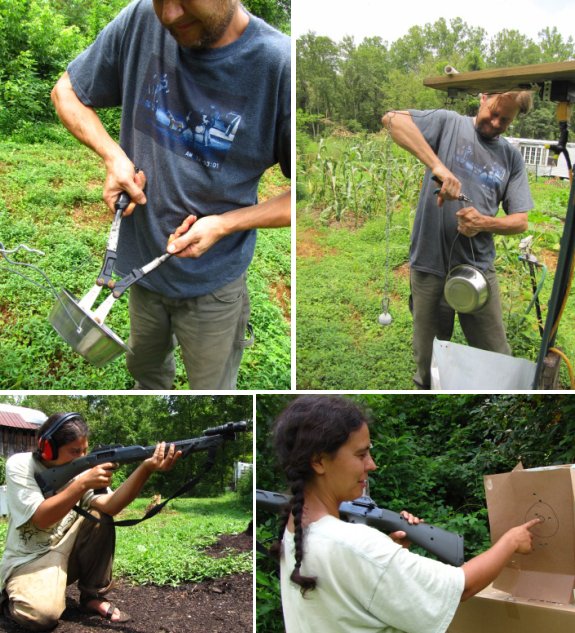
Anna noticed some additional
deer damage near the sweet potato leaves this morning.
Sigh.........
I noticed a mother deer with
two small ones yesterday near a neighbor's mail box when I was driving
back from the post office. They seemed more bold than most deer and
took a few seconds to scurry off into the woods where as most deer
around here bolt at the slightest hint of a car. I'm thinking it's the
same trio that's been attacking our garden since the 22
hour power outage we had last month.
We changed one of the mechanical
deer deterrent clangers
from a pet bowl to an old baking pan and Anna brushed up on her
shooting skills. If things get much worse we'll start taking turns
waking up early in hopes of ambushing the offending deer while at the
same time adding some venison to our winter meal plans.
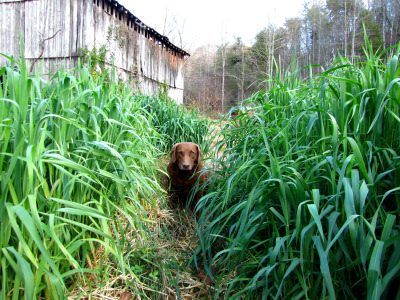 By
now, parts of your summer garden are probably toast. That early
sweet corn should be long gone, maybe you pulled out some buggy beans, and you're about to dig
your potatoes. Or perhaps you have trouble zones where the soil
wasn't good enough to support much of a crop and you're thinking about
writing that bed off entirely. Once you set aside some good
ground for your fall
garden, now's the
perfect time to plant the rest in winter cover crops --- they'll create
organic matter, prevent erosion, cut down on winter weed growth, and
add beauty to the winter garden.
By
now, parts of your summer garden are probably toast. That early
sweet corn should be long gone, maybe you pulled out some buggy beans, and you're about to dig
your potatoes. Or perhaps you have trouble zones where the soil
wasn't good enough to support much of a crop and you're thinking about
writing that bed off entirely. Once you set aside some good
ground for your fall
garden, now's the
perfect time to plant the rest in winter cover crops --- they'll create
organic matter, prevent erosion, cut down on winter weed growth, and
add beauty to the winter garden.
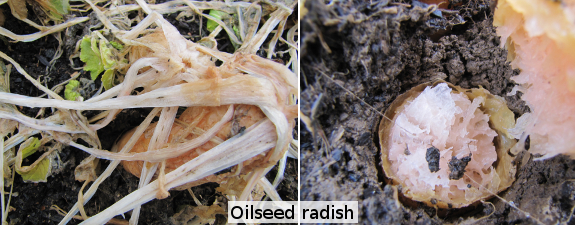
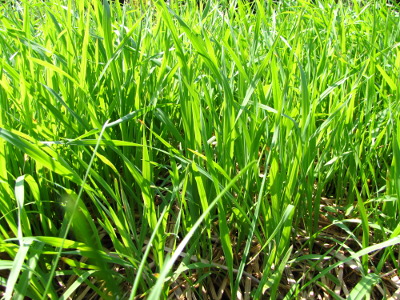 The
perfect winter cover crop for a no-till garden can handle problematic
soil conditions, will thrive in the fall and early winter, then
naturally dies back when the coldest part of winter hits. Here in
zone 6, I've found only two winners that really fit the bill --- oats and oilseed
radishes. Oats
have the advantage that they are available at my local feed store
(which means the seeds are dirt cheap) and the plants leave behind a
light mulch that will protect the soil until it's time to plant summer
vegetables. Oilseed radishes hold their own, though, by aerating
and adding organic matter deep in poor soil, then rotting fast enough
that I can plant spring vegetables directly behind them. After a
year of experimentation, I've decided that oilseed radishes will go
into the very poorest soil of my garden while oats will be planted
almost everywhere else.
The
perfect winter cover crop for a no-till garden can handle problematic
soil conditions, will thrive in the fall and early winter, then
naturally dies back when the coldest part of winter hits. Here in
zone 6, I've found only two winners that really fit the bill --- oats and oilseed
radishes. Oats
have the advantage that they are available at my local feed store
(which means the seeds are dirt cheap) and the plants leave behind a
light mulch that will protect the soil until it's time to plant summer
vegetables. Oilseed radishes hold their own, though, by aerating
and adding organic matter deep in poor soil, then rotting fast enough
that I can plant spring vegetables directly behind them. After a
year of experimentation, I've decided that oilseed radishes will go
into the very poorest soil of my garden while oats will be planted
almost everywhere else.
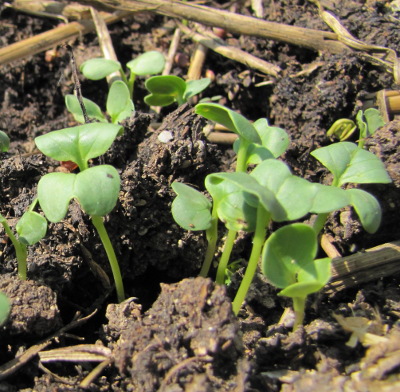 So, when do you plant winter
cover crops? Again, this will be climate specific, but I plant
oats betwen August 1 and September 15 and oilseed radishes between
August 1 and September 7. If you plant too late, your cover crops
won't do much good and you'll instead enter the next garden year with
lots of weeds. On the other hand, plant too early and your cover
crops might go to seed and produce weed problems of their own (although
you can stave this off with oats by mowing the mature plants.)
So, when do you plant winter
cover crops? Again, this will be climate specific, but I plant
oats betwen August 1 and September 15 and oilseed radishes between
August 1 and September 7. If you plant too late, your cover crops
won't do much good and you'll instead enter the next garden year with
lots of weeds. On the other hand, plant too early and your cover
crops might go to seed and produce weed problems of their own (although
you can stave this off with oats by mowing the mature plants.)
Unless you have fancy
equipment to do the work for you, cover crops aren't worth the extra
effort of seeding in rows. Instead, I've had good luck
broadcasting oat seeds on the soil surface and covering them with a
very light mulch of straw to keep the ground moist 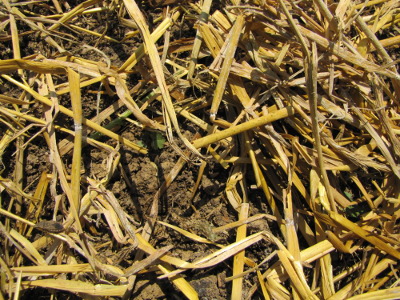 while preventing seed
predation by our
intelligent sparrows and cardinals. Radish seeds are less tasty,
so I often toss them directly onto the soil surface with no further
care. (Do be aware that in really hot, dry weather, the radish
seedlings can burn to a crisp if planted this way.) A safer (but
more time-consuming method) for planting both is to rake
back the top half inch of soil, broadcast your seeds, and pull the soil
back overtop.
while preventing seed
predation by our
intelligent sparrows and cardinals. Radish seeds are less tasty,
so I often toss them directly onto the soil surface with no further
care. (Do be aware that in really hot, dry weather, the radish
seedlings can burn to a crisp if planted this way.) A safer (but
more time-consuming method) for planting both is to rake
back the top half inch of soil, broadcast your seeds, and pull the soil
back overtop.
There are several winter
cover crops that can be planted later than September 15, but I've found
that barley, crimson clover, and (especially) annual ryegrass are tough
to kill
without tilling.
I suspect that any cover crop that can be planted within a month of the
first frost date will be too cold hardy to die on its own over the
winter. For beginners who live in zone 6 or colder, I'd recommend
sticking to oats and oilseed radishes this year for a beautiful and
bountiful winter cover crop.
We've been liking our Kobalt
Neverflat wheelbarrow so much that we decided to get it a
companion.
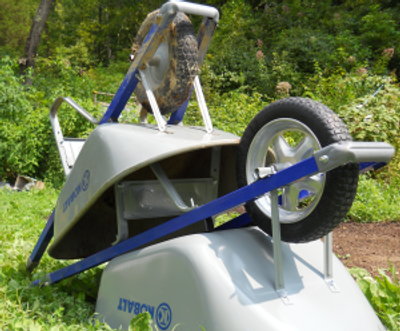
The guy at the store said it
was a long shot, but if they spark within the first 90 days then you've
got at least a 20 percent chance at producing some viable hybrids. This
particular species has been known to have litters as high as 10 little
ones, but 5 is more common.
Of course we won't need that
many wheelbarrows if the coupling does happen, but I have a feeling it
won't be too difficult to find good homes for a handful of young Kobalts
ready to haul their way into a lucky gardener's heart.
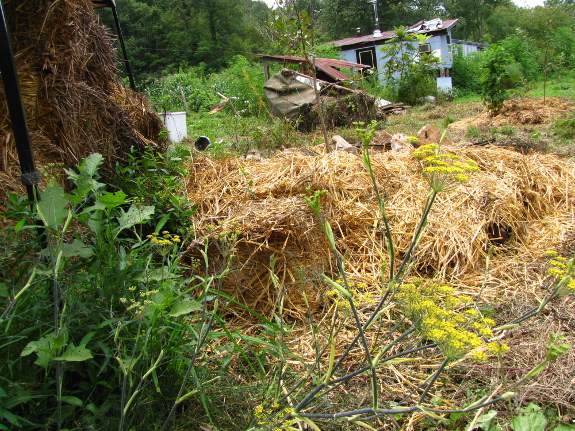
The forest garden area we
renovated on Thursday
has been a major experimenting ground for me because I'm trying to find
a way to grow useful plants on highly degraded soil. Previous
owners had used this spot as a pasture, and I suspect they overgrazed
it so much that every bit of topsoil eroded away. As a result,
there's a gully leading from the forest garden down to the floodplain,
absolutely no topsoil above the bare clay remaining in 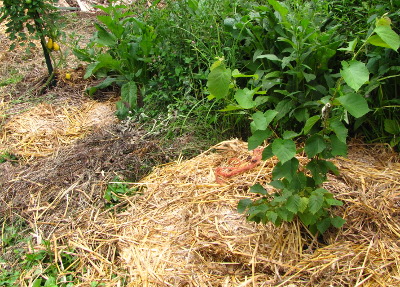 place, and a
very high water table. On the positive side, the spot gets good
sun and is close to our trailer, so it's easy to keep the deer
out. Clearly, the ground is worth renovating back into production.
place, and a
very high water table. On the positive side, the spot gets good
sun and is close to our trailer, so it's easy to keep the deer
out. Clearly, the ground is worth renovating back into production.
I'm slowly figuring out
ways to grow things in this extremely sub-prime
soil. The trick is to raise the plants' roots up high enough that
they don't drown while also adding enough organic matter and mulch that
the plants have something to eat and don't dry to a crisp in the summer
sun. Planting
trees in raised beds
works well for year one, but by year two the trees want to spread their
roots further, so I need to keep expanding the mound --- this winter's hugelkultur
donuts seem to have
been a good option in that regard.
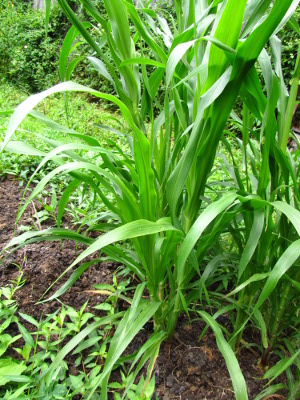
Since there's a lot of
empty space between the young fruit trees, I've also been
experimenting with making instant raised beds out of a layer of
cardboard topped by a bunch of composted manure. I can plant
annual crops on these rich raised beds and get a return on my
investment in year one. Meanwhile, by attaching the vegetable
beds to my tree islands, I'm also giving my fruit trees room to
grow. This idea works great if you mulch the manure beds
immediately so the top doesn't crust up, then transplant in tomatoes or
direct-seed squash into small, mulch-free areas. Without mulch,
though, the cowpeas, field corn, and amaranth I planted in another bed
barely germinated (although pearl millet seems to be hardy enough that
even scattered on the manure surface, enough seeds sprouted to make
the stand pictured here.)
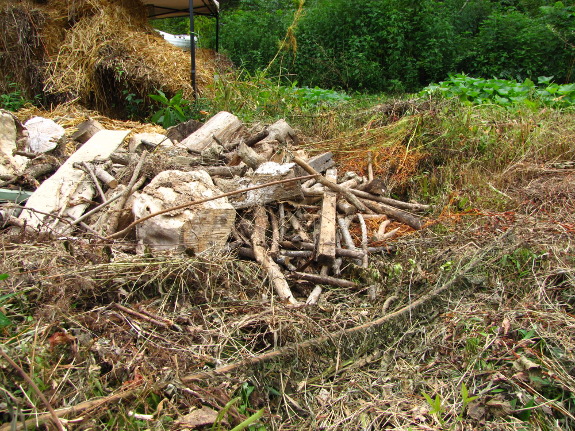
When Mark cut all of the
weeds I'd let grow up over our heads, I raked
some into piles alongside the tree beds for a new experiment. My
hope is that they'll rot down slowly enough that the greenery will act
like a kill mulch and smother weeds underneath. Meanwhile, the
composting weeds will add organic matter and height to the soil.
I even threw some firewood that was too punky to
split into the lowest spot for yet more height and organic matter.
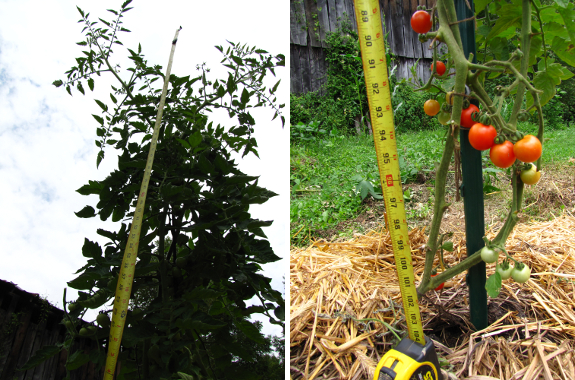
The beauty of
permaculture is that every problem can be viewed as a
benefit. Yes, this part of the garden is extremely troubled, but
the high groundwater acts to subirrigate
my beds, keeping roots moist and the leaves dry. The tomatoes in
the forest garden are taller than the unwatered tomatoes in tomato
alley and less blighted than the tomatoes in the watered part of
the mule garden. Maybe I should plant all of my tomatoes here
next year?
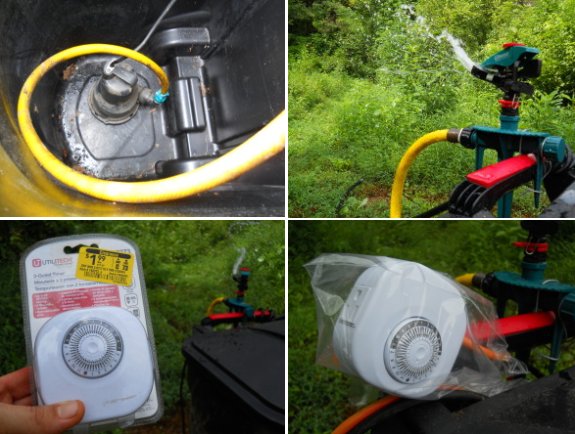
1. Place submersible pump at
the bottom of a large trash can.
2. Hook modified garden hose
from pump to sprinkler.
3. Fill trash can with water
and scented soap.
4. Adjust timer so that pump
turns on for a short burst and off for maybe an hour.
The goal is to spook the offending deer with a fresh, unnatural scent.
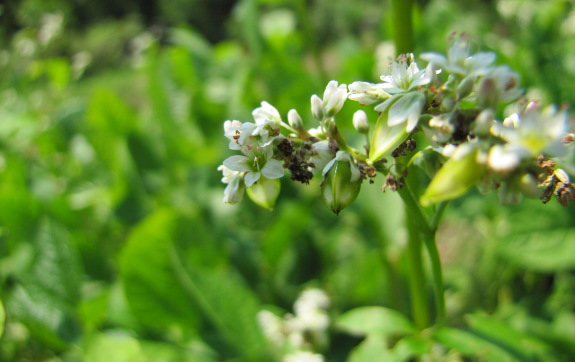
So you took my advice
and planted buckwheat and/or cowpeas as a quick
summer cover crop,
but you've actually got a longer fallow window than the cover crops
need. Once you start to see tiny fruits forming on the cover
crops (like the green triangles in the photo above), it's time to get
them out of there so that they don't set seeds and become a weed
problem.
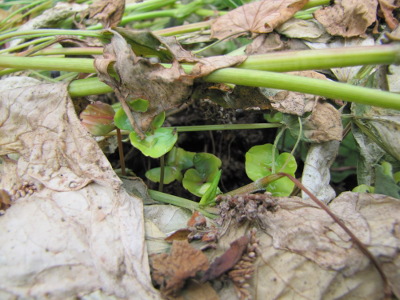 Why not toss another round of
summer cover crop seeds on the ground before cutting, then let the
first cover crop act as a light mulch to promote germination of the
later planting? I tried out this method a week ago, and little
buckwheat seedlings are already poking up through the debris.
I'll let you know how solid of a stand I end up with, but if this
planting method works, it's definitely the easiest way of getting
summer cover crops established.
Why not toss another round of
summer cover crop seeds on the ground before cutting, then let the
first cover crop act as a light mulch to promote germination of the
later planting? I tried out this method a week ago, and little
buckwheat seedlings are already poking up through the debris.
I'll let you know how solid of a stand I end up with, but if this
planting method works, it's definitely the easiest way of getting
summer cover crops established.
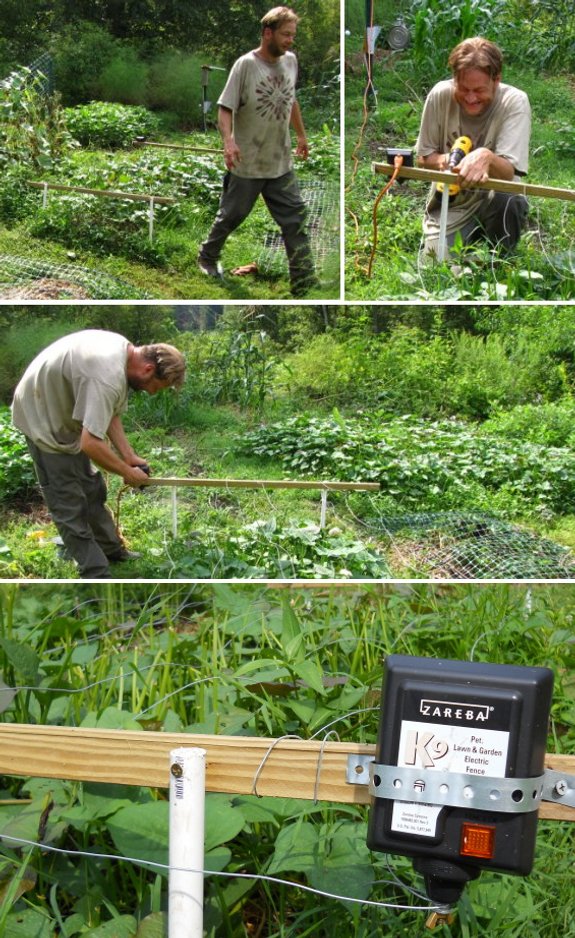
The deer came back last night
and ate more sweet potato leaves.
We've now got a 110
volt surprise waiting for them when they return.
Cue Evil laugh.
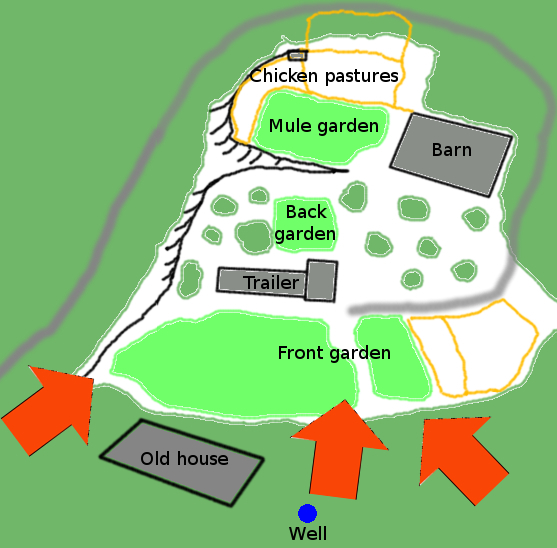
As much as I swear by
Mark's deer deterrents, I'm coming to realize that
they're a bandaid. The ultimate solution to keeping deer out of
our garden is going to require no electricity, because power outages
have become our Achilles heel.
On the larger scale, I
think the solution is hunting. Unfortunately, the game laws (and local hunter
ethic) in our area are stacked in the favor of increasing the deer
population, so we're
unlikely to be able to solve our own problem by shooting a few deer.
Instead, I think we need
to prevent the deer damage at a medium scale by considering where the
deer enter our garden. When we first moved in, the deer came from
all directions, but I've noticed that the mule and back gardens have
shown absolutely no signs of deer damage for the last year and a
half. Instead, the deer are only entering at the three locations
marked by arrows on the map above. So what are we doing right in
some places, and can we replicate it to save the beleaguered front
garden?
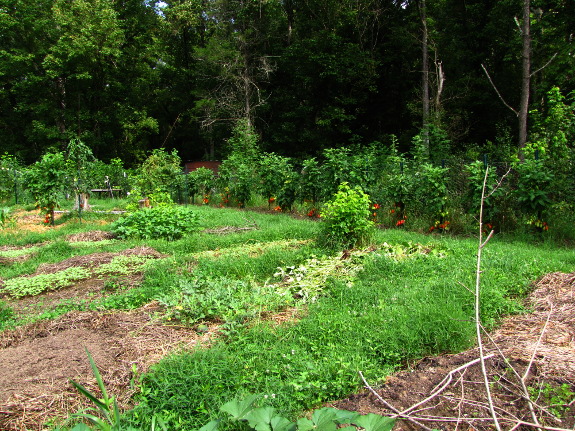
The reason the back and
mule gardens are untouched is because they are moated in. On the
north side, chicken pastures and the barn form a barrier that's too
uninteresting to deer to make it worth their while to cross. I'm
quite aware deer can easily leap a five foot fence if they want to, but
since nothing in the chicken pasture looks interesting and since we're
down there so often, they take the path of least resistance and stay
away. I've read permaculture books that call this strategy
building a "chicken moat."
The west side of the
back and front gardens is protected by an extremely steep slope.
Lucy has a path she sometimes takes down this escarpment when she's in
a big hurry, but so far, the steepness has made a good barrier to
deer. Again, path of least resistance.
On the east side of our
growing zones, the barn and another chicken pasture protect the
majority of the boundary. Three years ago, deer sometimes walked
up the driveway and into our domain, but I think some combination of
uninteresting food plants within the first few hundred feet combined
with our frequent activity in that zone keeps the deer away.
So our only real problem
now is to the south. If we could prevent the deer from walking
into that part of the garden, we would be protecting our entire
perimeter without electricity. But how?
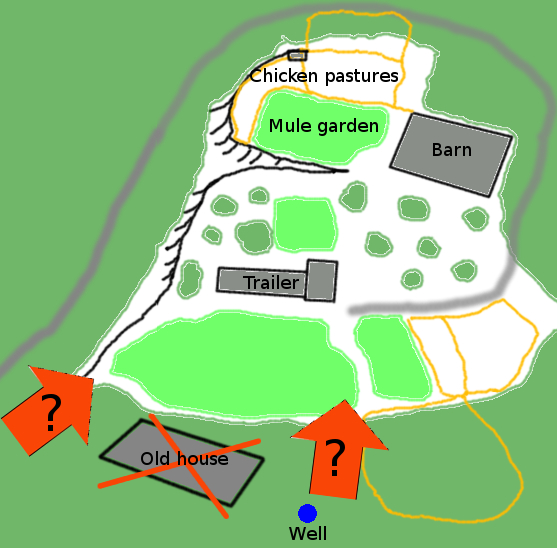
Adding another chicken
pasture to moat off the southeast corner is already on the drawing
board, but I'm unwilling to pasture chickens within the watershed of
the well. As you can see in the aerial photo below, there's a
little hill between the south pastures and the well, which protects the
quality of our drinking water, but I'm leery of grazing chickens any
closer.
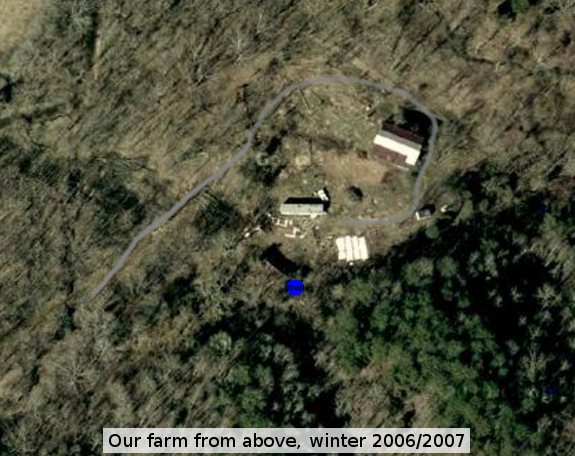
The jungle of weeds that
has grown up around the mostly-torn-down old house definitely makes the
deer feel safer when they come in from the south, so house removal is
on the to do list as well. But I think that even if the south
border was mown to remove all deer shelter, the garden would still look
enticing, especially since we don't walk up there very often. Any
ideas for a permaculture deer barrier that will protect the southwest
quadrant?
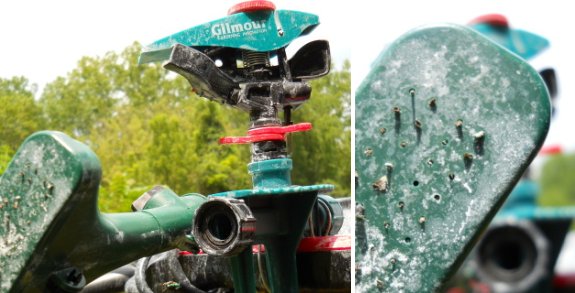
The deer came back the night
I installed the StinkMaster
smelly sprinkler system,
but they entered at a different spot, which might indicate a behavior
of avoidance to the smell zone.
One obvious problem is the soapy
water clogging up the sprinkler head. I tried switching to a hand
held shower unit and it still clogged, but at a slower rate.
We got a call from the game
warden yesterday and he gave us a 10 day kill permit. I'll save those
details for tomorrow's post.
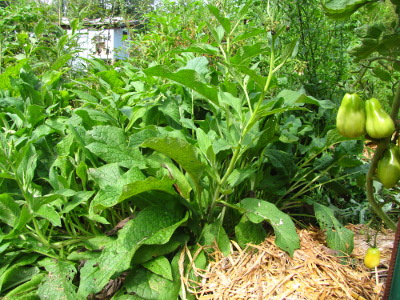 If
forest garden enthusiasts are entirely honest, I think what we find
most intriguing is the idea of a semi-self-maintaining system that
gives you food with very little work once it's established. In
case I'm not the only lazy forest gardener out there, I thought I'd let
you know which plants really thrived on total
neglect (or outright
abuse) in my extremely
poor soil.
If
forest garden enthusiasts are entirely honest, I think what we find
most intriguing is the idea of a semi-self-maintaining system that
gives you food with very little work once it's established. In
case I'm not the only lazy forest gardener out there, I thought I'd let
you know which plants really thrived on total
neglect (or outright
abuse) in my extremely
poor soil.
Comfrey. I planted
comfrey directly into the ground, cut the leaves multiple times, let
Mark mow the plants to the ground, and then forgot about them for six
months until the
surrounding weeds were eight feet tall. When I came back in to
hand-weed the spot, I found the comfrey happily growing and blooming,
weed-free. The downside of comfrey, of course, is that you'll
never kill it so
that location will be home to comfrey forever.
But if you've got space far enough from fruit trees that it won't
compete
with the tree too much for nitrogen, comfrey is definitely a
neglected-forest-garden winner.
Fennel. I transplanted a
few fennel starts into another spot, again directly into the awful
soil. The fennel was run over by the truck, mowed to the ground
multiple times, and then ignored, but the plant kept popping back up
and even looked
so obviously cultivated that Mark started mowing around it. With
its deep taproot, fennel is probably tough to eradicate, but it doesn't
run like mint and does attract a lot of beneficial insects to its
flowers.
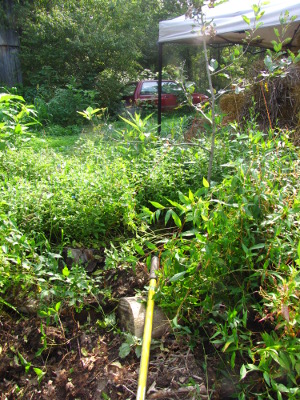 Mint. I know I'm
starting to sound like a broken record, but I transplanted some mint
into the poor soil and let Mark mow it down multiple times and drive
over it with the truck. The mint grew so happily that
it took over the nearby hugelkultur mound that I'd made for my
apple. That's the major downside of mint --- it's easier to
eradicate than comfrey, but spreads much more thoroughly if you don't
install a root barrier. I couldn't tell how much or if the mint
was competing with the tree for nutrients, but I ripped it out of the
immediate vicinity just in case.
Mint. I know I'm
starting to sound like a broken record, but I transplanted some mint
into the poor soil and let Mark mow it down multiple times and drive
over it with the truck. The mint grew so happily that
it took over the nearby hugelkultur mound that I'd made for my
apple. That's the major downside of mint --- it's easier to
eradicate than comfrey, but spreads much more thoroughly if you don't
install a root barrier. I couldn't tell how much or if the mint
was competing with the tree for nutrients, but I ripped it out of the
immediate vicinity just in case.
I think that these three
perennials are good candidates for renovating poor soil a
good distance from fruit trees. They all produce
copious organic matter while comfrey is also a dynamic accumulator of
silica, nitrogen, magnesium,
calcium, potassium, and iron and fennel is a dynamic accumulator of
sodium, sulfur and potassium. I suspect that the trick to using
them wisely is to map out the eventual spread of your fruit tree
canopies, then plant comfrey, mint, and fennel in the spaces where the
tree leaves will never reach (adding a root barrier if you're including
mint in the mix.) Trees
will spread their roots beyond the canopy, but by the time your trees
are mature enough to reach this intercanopy area, they roots will be
better able to compete and the understory weeds will have produced
enough good soil that there won't be such a fight over nutrients.
I wish I'd though of this before scattering the three willy nilly
throughout the forest garden!
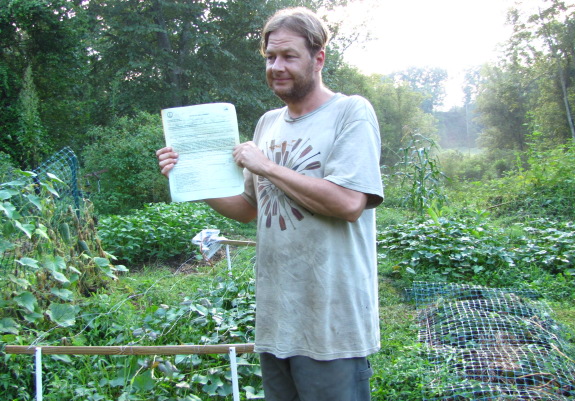
1. Call the D.G.I.F. office
in the state capital. Did that on Monday.
2. Explain situation to
dispatcher who passes message along to the actual warden.
3. Wait.....and wait some
more....and then call again on Wednesday.
Our local game warden called
us back that same day to set up a time to meet. He was free and in the
area so I agreed to meet him out at the mailbox. He was very
professional and courteous and sort of interviewed me there in our
driveway. I guess I proved to him that I was an exasperated gardener and
not some blood thirsty hunter who couldn't wait til deer season
started. He decided to give me the permit without walking back to
actually inspect the damage and took some time to explain how a kill
permit works.
1. No Bucks!...that seemed to
be one of the more important distinctions.
2. It's the only time you are
legally allowed to use spotlights to hunt deer.
3. We've only got 10
days....and no hunting on Sunday.
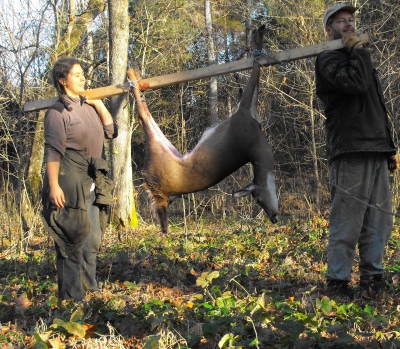
I asked him why no hunting on
Sundays? He just shrugged and said "Something to do with the blue laws."
I imagined a scene of church pews being almost empty during hunting
season before these laws were enacted, which I guess is what would
prompt such a law.
The picture to the right here
is Anna's
very first deer back in 2009. I have a feeling we'll be carrying her second home
within the next 9 days.
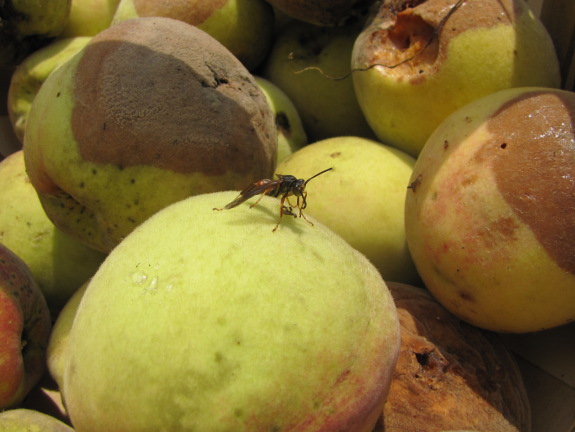
This would have been a
bumper year for peaches...if brown rot hadn't hit. Here's what
our extension
service website has
to say about it:
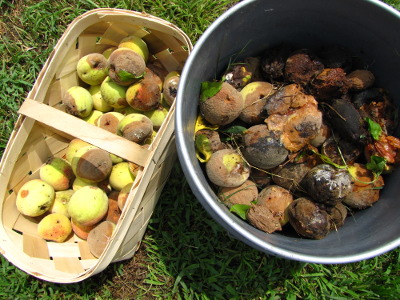 During warm, wet summers, the
fungus that causes brown rot infects stone fruits starting at the
blossom stage, continuing through cankers on twigs, and culminating in
peaches that rot before they fully ripen. We lost every peach
(save one) on our younger peach tree due to endless rain, and even
though I dutifully picked rotting peaches off the kitchen peach every
week, brown rot took nearly the entire crop there too. I ended up
with a five gallon bucket of rotten peaches, about two quarts of
semi-ripe peaches to turn into fruit leather, and just enough ripe
fruits for one dessert.
During warm, wet summers, the
fungus that causes brown rot infects stone fruits starting at the
blossom stage, continuing through cankers on twigs, and culminating in
peaches that rot before they fully ripen. We lost every peach
(save one) on our younger peach tree due to endless rain, and even
though I dutifully picked rotting peaches off the kitchen peach every
week, brown rot took nearly the entire crop there too. I ended up
with a five gallon bucket of rotten peaches, about two quarts of
semi-ripe peaches to turn into fruit leather, and just enough ripe
fruits for one dessert.Since I'm not willing to resort to fungicides, it may turn out that we simply can't ripen peaches during wet years, but there are some tricks I can try to at least lessen future catastrophes.
- Keep the leaves dry. I already prune my peaches to the open center system, which helps the leaves dry off as fast as possible, and I can't do anything about the rain. But I am going to tweak our sprinkler arrangements since they currently hit a little bit of our peach trees when I water the garden.
- Sanitation. The
fungus overwinters in so-called mummies --- dried up fruit that sit on
the tree or on the ground. I do my best to remove all bad fruits,
but I think I'm going to find a way to turn chickens under our peaches
for a little while right after harvest to catch anything I miss.
- Work harder to prevent insect
damage. Unripe peaches are usually safe from brown rot,
but not if their protective skin has been damaged by insects. Oriental
fruit moth larvae were a huge problem in our peaches last year, and
even though I clipped off injured twigs and thinned out infested
fruits, some still got past my radar. (I'd say my sanitation
practices reduced the insect damage by about 75%.) I'm hoping
that mini chicken pastures will help with this problem as well since
the moths overwinter in debris on the ground and chickens love looking
for insects under mulch.
- Remove the most susceptible trees. Nectarines tend to be more prone to brown rot than peaches are, and in retrospect, that's probably why our nectarine --- covered with flowers this past spring --- set no fruit. The dwarf cherry that set twelve fruits and then had them all rot before ripening also did its part to let the fungus keep reproducing all spring. Neither of these trees is happy here, so I'm going to finally rip them out so that they can't serve as reservoirs of disease that will later infect my good trees.
- Give my fruit trees less compost.
One study suggests that too much nitrogen can make trees more prone to
infection by brown rot. Perhaps I need to back off on the compost?
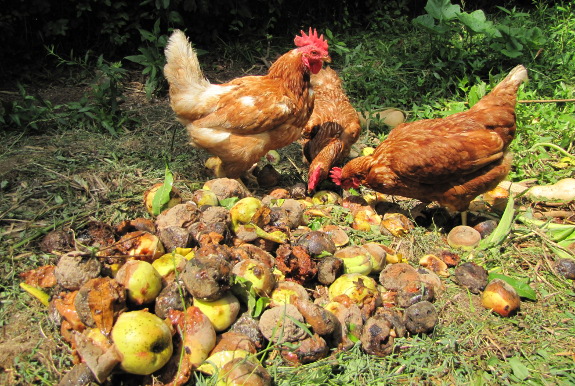
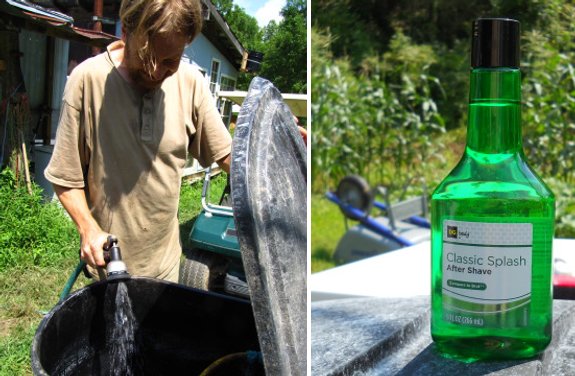
Cleaned out the StinkMaster
for another round of experimentation.
The next artificial scent I
plan to try is the above Classic Spash,
which can be found at local Dollar General stores for $1.50.
I'll post about the results
sometime next week once I've tested the clogibility of the new After
Shave, which in my opinion has a much more repulsive odor than the Irish Spring
soap.
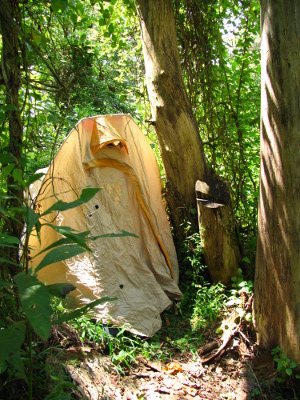 Camp
out beside the deer
entrance to garden.
Camp
out beside the deer
entrance to garden.
Reality: I adore sleeping close to the earth, but miss spending evenings with my husband. Nights with Lucy nearby aren't nearly as much fun, and I wake up every time she moves thinking she's a deer. And --- about the hunting idea --- how am I going to shoot a deer in the dark again? On the plus side, the deer stop using this path and the garden is momentarily safe.
Carry
the gun while walking Lucy.
Reality: The only deer I see are far away in the neighbor's hay field. I'm unwilling to trespass and they're too distant to hit anyway.
 Hang out on the plateau overlooking the
floodplain in the evening.
Hang out on the plateau overlooking the
floodplain in the evening.
Reality: No deer pass by. When I pay more attention, I notice that all tracks in the area are at least a week old.
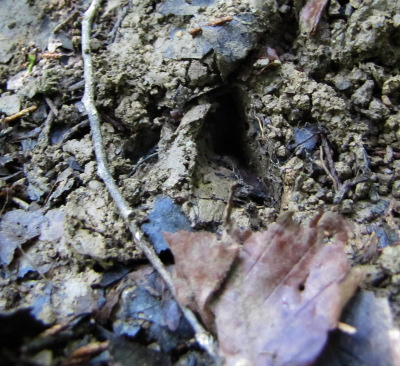 Find out where the deer actually go and stake
out the spot with a book.
Find out where the deer actually go and stake
out the spot with a book.
Reality: Lucy follows me and makes a ruckus for half an hour, but she finally settles down. By the time I'm well engrossed in my book, I barely notice the two does walking down the trail toward me. They snort in alarm and my adrenaline turns me stupid. Rather than waiting in hopes they'll come closer or at least turn broadside so I'll have more of a target, I fire from my lounging bookworm position at one deer's front-on chest...and miss.
I really am making
progress...or so I tell myself. At least I finally shot at a deer
on my third hunting day. Now, if I can just shoot at a deer and hit it. Do you think they'll
come back to that same spot twenty four hours later?

 Roland made a good point
yesterday about the StinkMaster
After Shave being diluted in water, which got me to thinking of an
alternative way of dispersing liquids through the atmosphere.
Roland made a good point
yesterday about the StinkMaster
After Shave being diluted in water, which got me to thinking of an
alternative way of dispersing liquids through the atmosphere.
Bubbles?
BionicMechanic.com has the
details for building an automatic bubble machine for very little money.
I'm not sure how much
of a scare factor the bubbles might have on the deer, but if such a
machine was set up on a timer like the StinkMaster, then maybe an hourly bubble show
would be enough to keep a repulsive scent lingering in the area.
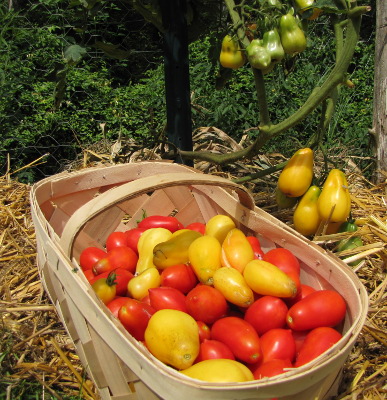 I
used to hate spaghetti night when I was a kid. My parents made
the sauce from scratch, and the result was both watery and chunky ---
pretty much par for the course with homemade tomato sauces. When
I was finally introduced to storebought spaghetti sauce, I fell in
love. Three years of trial and error later, I finally figured out
how to make a full-bodied tomato sauce with homegrown tomatoes that
tastes even better than the stuff in the jar and is just as good for
you as the kind my parents made.
I
used to hate spaghetti night when I was a kid. My parents made
the sauce from scratch, and the result was both watery and chunky ---
pretty much par for the course with homemade tomato sauces. When
I was finally introduced to storebought spaghetti sauce, I fell in
love. Three years of trial and error later, I finally figured out
how to make a full-bodied tomato sauce with homegrown tomatoes that
tastes even better than the stuff in the jar and is just as good for
you as the kind my parents made.
Start
with roma tomatoes.
There are two main types of tomatoes when it comes to cooking --- romas
and everything else. Roma tomatoes have less water and more flesh
than any other kind of tomato, and they also tend to have few enough
seeds that I make my sauces with skins and seeds in. It's okay to
include some extra slicers and tommy-toes as long as the romas
overpower their wateriness and seediness.
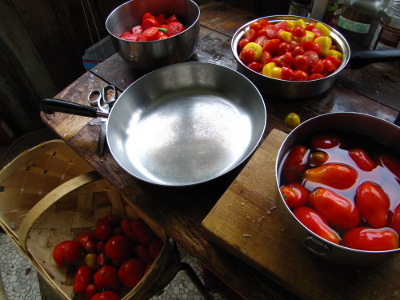 Get out your biggest skillet. The trick to making a
spaghetti sauce that turns out creamy and not watery is to let the
pectin in the tomatoes do its magic --- you're basically making
tomato jam. To that end, you're in a race against the naturally
occurring enzymes that start to break down the pectin in your tomato as
soon as the flesh is cut. The enzymes are activated by air and
then denatured (made inactive) by heat, so you need to keep your
tomatoes intact until the last minute, then heat the whole mass of
tomatoes up as fast as possible. Thus the skillet --- more
surface area on the burner means your sauce comes to a boil
faster. Plus, there's more surface area through which excess
water can cook off.
Get out your biggest skillet. The trick to making a
spaghetti sauce that turns out creamy and not watery is to let the
pectin in the tomatoes do its magic --- you're basically making
tomato jam. To that end, you're in a race against the naturally
occurring enzymes that start to break down the pectin in your tomato as
soon as the flesh is cut. The enzymes are activated by air and
then denatured (made inactive) by heat, so you need to keep your
tomatoes intact until the last minute, then heat the whole mass of
tomatoes up as fast as possible. Thus the skillet --- more
surface area on the burner means your sauce comes to a boil
faster. Plus, there's more surface area through which excess
water can cook off.
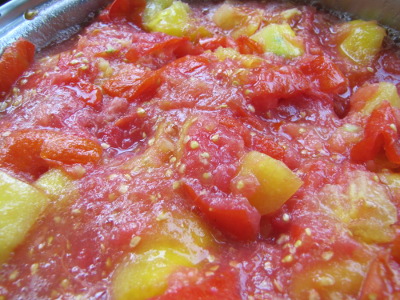 Prepare your tomatoes. Romas don't have any
core to speak of, so after a quick rinse, you can just lop off the very
top where the stem was attached. Quickly chop each roma into
three pieces and toss them in the skillet. (Note: I'm of the
"skins and seeds are good for you and taste fine" school of
thought. If you disagree, you'll want to remove both at this
stage.) Once you've cut all of the tomatoes into large chunks,
take big handfuls and squeeze them until there's enough liquid in the
pan that the tomatoes won't stick to the bottom and burn.
Prepare your tomatoes. Romas don't have any
core to speak of, so after a quick rinse, you can just lop off the very
top where the stem was attached. Quickly chop each roma into
three pieces and toss them in the skillet. (Note: I'm of the
"skins and seeds are good for you and taste fine" school of
thought. If you disagree, you'll want to remove both at this
stage.) Once you've cut all of the tomatoes into large chunks,
take big handfuls and squeeze them until there's enough liquid in the
pan that the tomatoes won't stick to the bottom and burn.
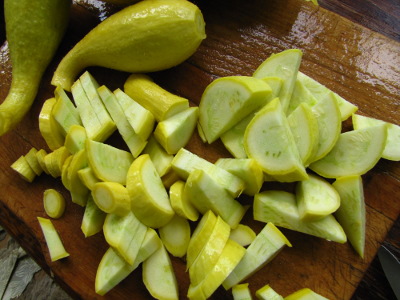 Add other ingredients. Put your skillet of
tomatoes on the stove on medium-high heat (stirring the contents
occasionally so nothing sticks) and add anything else you like in your
spaghetti sauce. One of my large skillets holds about a gallon of
tomatoes, and to this I generally add 1 onion (sliced), 3 cloves of
garlic (pressed), 3 or 4 dried bay leaves, and some salt and
pepper. At the very end, I'll also add a lot of fresh basil
leaves and will vainly try to fish the used bay leaves out. If
I'm going to add hamburger meat, I usually cook it up separately and
add the meat at the end. Squash, peppers, or other vegetables can
go in about thirty minutes before the sauce is done.
Add other ingredients. Put your skillet of
tomatoes on the stove on medium-high heat (stirring the contents
occasionally so nothing sticks) and add anything else you like in your
spaghetti sauce. One of my large skillets holds about a gallon of
tomatoes, and to this I generally add 1 onion (sliced), 3 cloves of
garlic (pressed), 3 or 4 dried bay leaves, and some salt and
pepper. At the very end, I'll also add a lot of fresh basil
leaves and will vainly try to fish the used bay leaves out. If
I'm going to add hamburger meat, I usually cook it up separately and
add the meat at the end. Squash, peppers, or other vegetables can
go in about thirty minutes before the sauce is done.
 Cook the sauce until it thickens. Delicious spaghetti
sauce has to be cooked long enough for the pectin to do its work.
I start the pan on medium-high until the contents are boiling hard,
then turn the heat down a bit at a time over the next hour or two until
the setting is on medium-low. During that time, the tomatoes will
cook down to about half their original volume. For quite a while,
you'll be stirring a pan of tomatoes and onions, but then, all of a
sudden, you can barely see individual components and the sauce tastes
and looks like sauce. Success!
Cook the sauce until it thickens. Delicious spaghetti
sauce has to be cooked long enough for the pectin to do its work.
I start the pan on medium-high until the contents are boiling hard,
then turn the heat down a bit at a time over the next hour or two until
the setting is on medium-low. During that time, the tomatoes will
cook down to about half their original volume. For quite a while,
you'll be stirring a pan of tomatoes and onions, but then, all of a
sudden, you can barely see individual components and the sauce tastes
and looks like sauce. Success!
Don't
worry if you scorch the bottom. I tend to forget to
stir nearly every batch at a critical stage and a bit of sauce sticks
to the bottom and burns. Whatever you do, don't
scrape that burnt bit back into the sauce and don't ignore it and keep
simmering. Instead, quickly pour off all of the good sauce into a
new skillet and set the scorched pan in the sink, filled with water, to
soak. As long as you don't stir the burnt sauce in or let the
good sauce sit on top of it long, you won't be able to taste the error
at all. (Maybe if you could, I'd be better about stirring and
wouldn't always let my spaghetti sauce burn?)
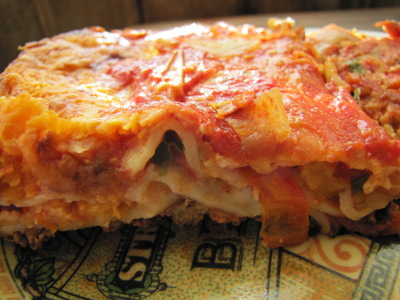 Lasagna is better for you than spaghetti. By now, I'm sure some
of you are wondering why I go to so much trouble to make spaghetti
sauce when we've deleted spaghetti from our diet and cut grains down to
a bare minimum. The same sauce can be used to make a high protein
and high vegetable lasagna that keeps my body healthy and my
spaghetti-loving tastebuds happy. To assemble a 9X13" pan of
lasagna, I use about a skillet and a half of spaghetti sauce, half this potsticker
dough recipe for the
noodles (which can be layered in uncooked), 1.5 pounds of hamburger
meat (cooked), quite a bit of cheddar, mozarella, and parmesan cheeses,
and any subset of cooked leafy greens, sliced summer squash, and sliced
mushrooms. Starting from tomatoes on the vine, it takes perhaps
three hours to make up a big pan of lasagna, but then we have quick
leftovers to heat up for lunch nearly all week!
Lasagna is better for you than spaghetti. By now, I'm sure some
of you are wondering why I go to so much trouble to make spaghetti
sauce when we've deleted spaghetti from our diet and cut grains down to
a bare minimum. The same sauce can be used to make a high protein
and high vegetable lasagna that keeps my body healthy and my
spaghetti-loving tastebuds happy. To assemble a 9X13" pan of
lasagna, I use about a skillet and a half of spaghetti sauce, half this potsticker
dough recipe for the
noodles (which can be layered in uncooked), 1.5 pounds of hamburger
meat (cooked), quite a bit of cheddar, mozarella, and parmesan cheeses,
and any subset of cooked leafy greens, sliced summer squash, and sliced
mushrooms. Starting from tomatoes on the vine, it takes perhaps
three hours to make up a big pan of lasagna, but then we have quick
leftovers to heat up for lunch nearly all week!
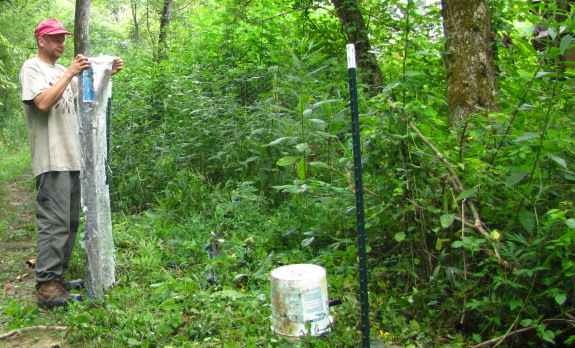
We had a rash of chicken
escapes this past weekend which has prompted us to start building poultry
pasture #6.
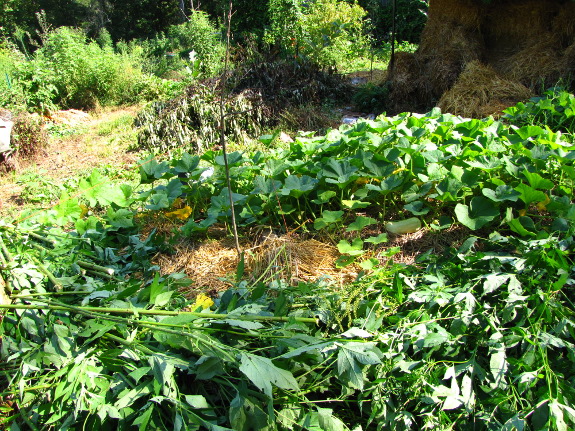
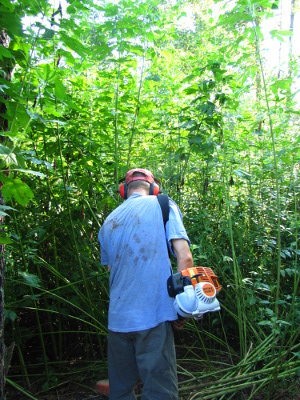 Mid to late summer is the
perfect time to start next year's no-till garden beds. Most of
the big weeds that grace neglected ground --- ragweed, wingstem, and
goldenrod for us --- are blooming or are about to bloom but haven't
gone to seed yet. At the pre- to mid-bloom stage of a plant's
life, the weed has pumped as much of its energy as possible into
creating viable blooms, so if you cut the plants now, they'll be
hard-pressed to regrow. (You take advantage of this fact when you
mow-kill
cover crops at this
same life stage.)
Mid to late summer is the
perfect time to start next year's no-till garden beds. Most of
the big weeds that grace neglected ground --- ragweed, wingstem, and
goldenrod for us --- are blooming or are about to bloom but haven't
gone to seed yet. At the pre- to mid-bloom stage of a plant's
life, the weed has pumped as much of its energy as possible into
creating viable blooms, so if you cut the plants now, they'll be
hard-pressed to regrow. (You take advantage of this fact when you
mow-kill
cover crops at this
same life stage.)
Meanwhile, midsummer is
the perfect time of year to smother lower-growing perennials (like
grasses and clover) in areas where you want garden beds to grow next
year. Cool season grasses have already gone to seed and are
currently trying to sock away as much solar energy as possible to store
in their roots and allow the plants to pop back up early next
spring. By covering up perennials in the middle of the summer,
you have the best chance of killing these hardy plants so that the soil
will be completely weed-free and ready for vegetables come spring.
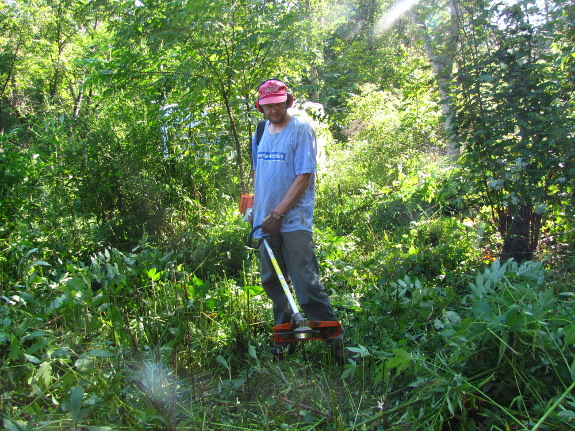
So "weed" in the title
of this post does double duty --- I'm using weeds to create a kill
mulch to smother other weeds. The main component of my weed kill
mulch is those fifteen
foot tall ragweed plants from one of our chicken pastures --- I'm pretty sure the
ragweed shaded out the understory and made it harder for our Cuckoo
Marans to find tender forage. Mark's ninja
blade made quick
work of the huge ragweed stalks, then I gathered them up and tossed
them over the fence to lay alongside the existing beds in the forest
garden.
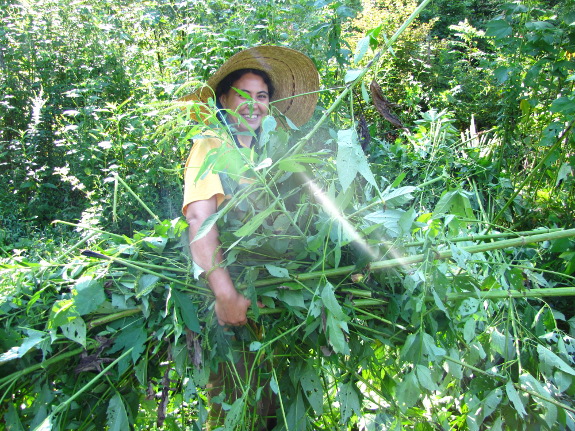
Even though the idea
makes a lot of sense, I should warn you up front that this is another
crazy experiment. That said, I already tried out a similar weed
kill mulch last week when I raked up all
of the stalks Mark whacked down in the forest garden itself and use them to increase my
mulched area. The weeds quickly died back to a black mass of free
mulch, so I'm pretty confident the weed kill mulches will work,
although they might need another layer of weeds added on top if
perennials start popping up through.
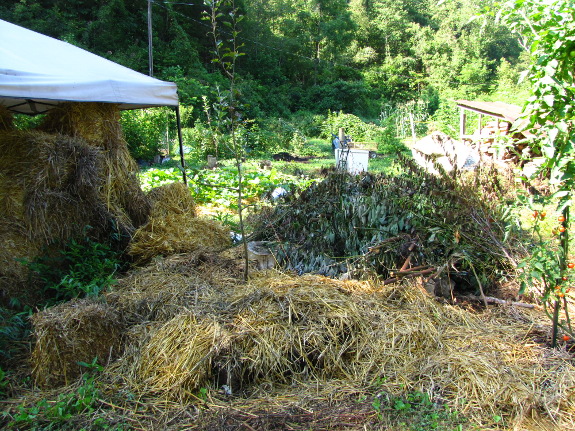
The other factor to
consider is the C:N
ratio of your
weeds. I had Mark cut a lot of saplings in one of the deer
danger zones, then I
piled them in another part of the forest garden in a sort of horizontal
brush pile (three or four feet deep.) Branches and young trees
are too woody to rot down into an acceptable mulch for vegetables by
next spring, so I'll either top them off with manure and turn the area
into a hugelkultur bed or just throw weeds on top and let the brush
pile slowly rot down. Ragweed cut at the blooming stage, though,
is only moderately woody, so I have high hopes we'll be able to plant
directly under those kill mulches next spring.
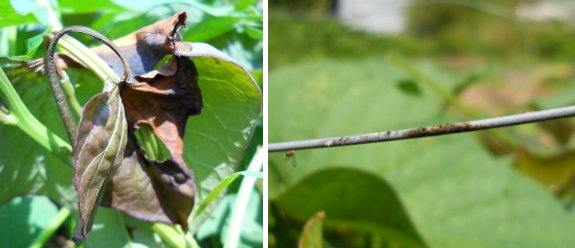
Anna noticed more deer damage
to the sweet potatoes on her morning tour.
"Not the ones by the Deer
Zapper though....right?"
Turns out a leaf grew just
tall enought to touch the electrical wire, which burned the leaf and
disarmed the Zapper.
Maybe I should have installed
the wire a bit higher. Perhaps some adjustable legs so that we can
raise it up as the plants grow.
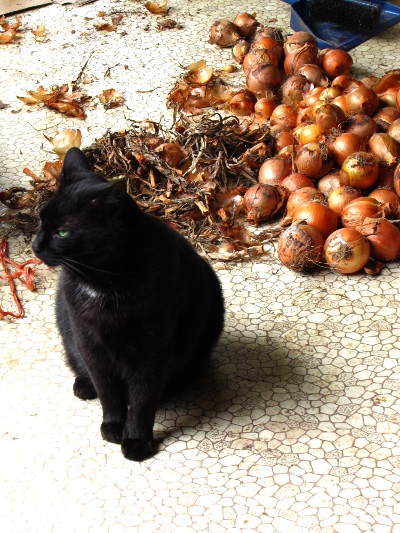 Huckleberry informed me that
it was high time I sorted through our onions, cut off the stems, and
put them away.
Huckleberry informed me that
it was high time I sorted through our onions, cut off the stems, and
put them away.
I'm sad to say that our
beautiful onion
braids all started breaking apart after hanging for just a few
days. I guess those folks on the internet who recommend you braid
a piece of rope in amid the leaves were right.
After several braids
fell to the ground, I ended up drying the onions on the anti-cat screen
atop the chick brooder. Our last set of chicks is due to hatch
this week, so I guess Huckleberry was right.
A considerable number of
onions were already slightly softened, presumably due to bruising from
their unexpected fall. Rather than sorting by size the way I
usually do, I instead used a squeeze test to pull out all of the onions
that need to be eaten in the next month. The
hard-as-a-storage-pear onions go in other bags to be used later.
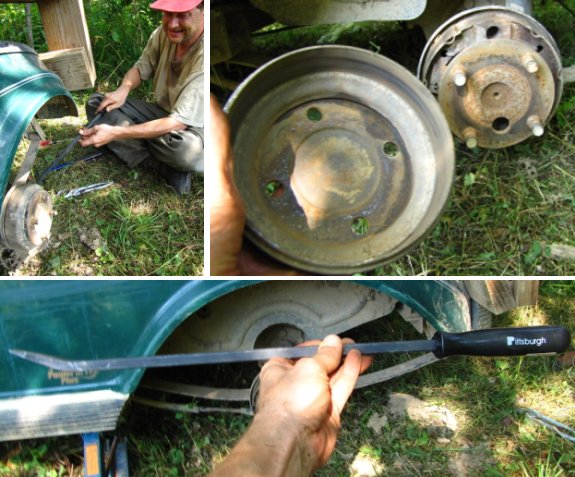
We've been hearing a rubbing
sound from the rear area of the golf cart and thought it was time for a
brake inspection.
I had some difficulty getting
the drum off. The main trouble was leaving the parking brake
engaged. In my defense it was getting very hot, which seems to increase
dumb mistakes for me.
Once the pressure was reduced
the drum started to back off with some serious effort from a
big pry bar. It took
about 10 minutes of prying. Pry a little on one side, do the other, and
then the top and bottom trying to keep it as even as possible.
 Mark would appreciate it if
you all could talk me out of it, but I'm currently thinking seriously
about goats. Our land is perfect for goats (lots of brush) as
long as I keep them out of the snail-friendly floodplain, and I think
that adding an herbivore to our menagerie would make the farm more
productive and fill an empty ecological niche.
Mark would appreciate it if
you all could talk me out of it, but I'm currently thinking seriously
about goats. Our land is perfect for goats (lots of brush) as
long as I keep them out of the snail-friendly floodplain, and I think
that adding an herbivore to our menagerie would make the farm more
productive and fill an empty ecological niche.
In the past, I've
steered clear because I'm unwilling to follow the lead of my neighbors
and chain a goat, and I didn't trust my fencing ability to keep these
wily animals out of our beloved garden. However, Sharon
Astyk (fondly known
as "blogger Sharon" in our dinner table conversations) assured me that
four foot fencing is enough to keep in her favorite variety ---
Nigerian dwarf goats.
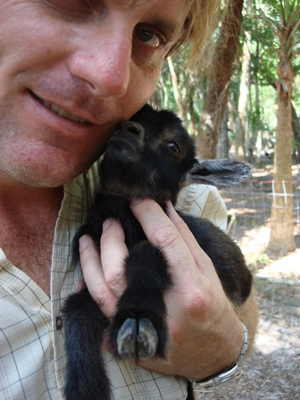 We've been doing a lot of
fencing this year for our chickens and already have nearly a tenth of
an acre of pasture (with two more pastures
partially built.) Since Nigerian dwarf goats are so small, I've
read that you can feed them on 0.13 to 0.16 acres apiece, which makes
goat pastures sound well within reach. In addition, our chickens
won't eat the woodier plants like ragweed and young trees, so it's
likely that we could add goats to the chicken pastures without taking
away much food from the chickens at all.
We've been doing a lot of
fencing this year for our chickens and already have nearly a tenth of
an acre of pasture (with two more pastures
partially built.) Since Nigerian dwarf goats are so small, I've
read that you can feed them on 0.13 to 0.16 acres apiece, which makes
goat pastures sound well within reach. In addition, our chickens
won't eat the woodier plants like ragweed and young trees, so it's
likely that we could add goats to the chicken pastures without taking
away much food from the chickens at all.
Most people plan to milk
year-round, but Sharon reports that if you breed your goats to kid in
the spring when forage is at its most abundant, you can let the goat
dry off for the winter and hardly have to feed any grain. That
means better quality milk and a more sustainable livestock
system. In addition, seasonal milking lets you go out of town
during the off season without finding a milking helper.
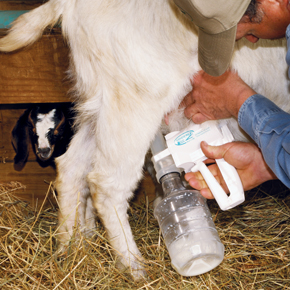 Sharon solves the twice a day
milking problem as well. She recommends milking your goats in the
morning, then putting the kid back with its mother to spend the day
grazing together. That way, you only have to milk once a day
rather than twice and your evenings are free. Meanwhile, Sharon
uses a modified breast pump to do the majority of the milking, which
saves her hands --- my carpal tunnel made the idea of daily milking
unlikely until I learned about this gadget --- and also lets an
untrained friend milk the goat if necessary.
Sharon solves the twice a day
milking problem as well. She recommends milking your goats in the
morning, then putting the kid back with its mother to spend the day
grazing together. That way, you only have to milk once a day
rather than twice and your evenings are free. Meanwhile, Sharon
uses a modified breast pump to do the majority of the milking, which
saves her hands --- my carpal tunnel made the idea of daily milking
unlikely until I learned about this gadget --- and also lets an
untrained friend milk the goat if necessary.
Using the seasonal,
once-a-day milking method, we'd end up with around 25 gallons of
milk from one Nigerian dwarf goat per year, which would fulfill our
dairy needs quite nicely. Sharon reports that milk from Nigerian
dwarf goats tastes just like cow milk and I've read that goat milk in
general is supposed to be easier to digest than cow milk. I used
to love milk until I stopped being able to drink the grocery store
stuff a few years ago, so I'm hopeful that goat milk could put me back
in business. Of course, you also get to eat goat meat in the fall
when those kids grow up.
I'm tempted to buy one
(or two if I think one would be lonely) male dwarf goats this winter to
see how he does on our pasture and with our fencing before committing
to the whole milking endeavor. Males are much cheaper than good
milking does, so it wouldn't be so 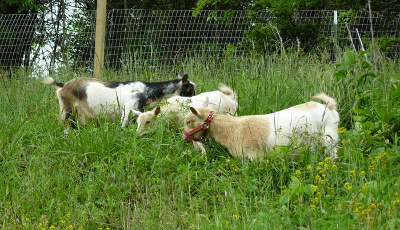 bad if the experiment didn't
work out and we had to eat the goat or sell him.
bad if the experiment didn't
work out and we had to eat the goat or sell him.
All of that said, there
are some very valid reasons not to get goats. First of all,
domesticated animals are a huge commitment, and I'm not sure if we're
ready to expand the menagerie. And I'm not clear on how the herd
dynamics would work out --- could we keep one doe and her kid, bringing
her to a local breeder when she's in heat, or would she be lonely in
the winter? Any more than one goat would mean doubling our
pasture area, which is feasible but more of a two year project.
Speaking of which, are our quick and dirty fences really good enough to
keep in even the tiniest goats? And do goats in the off season
fit our mandatory "can fend for itself for four days while we're out of
town" requirement? Finally, Mark's worried that Nigerian dwarf
goats are too cute to kill, which would make them less enticing.
Please chime in with
other reasons not to try out goats. I need someone to quench the
flame of my desire!
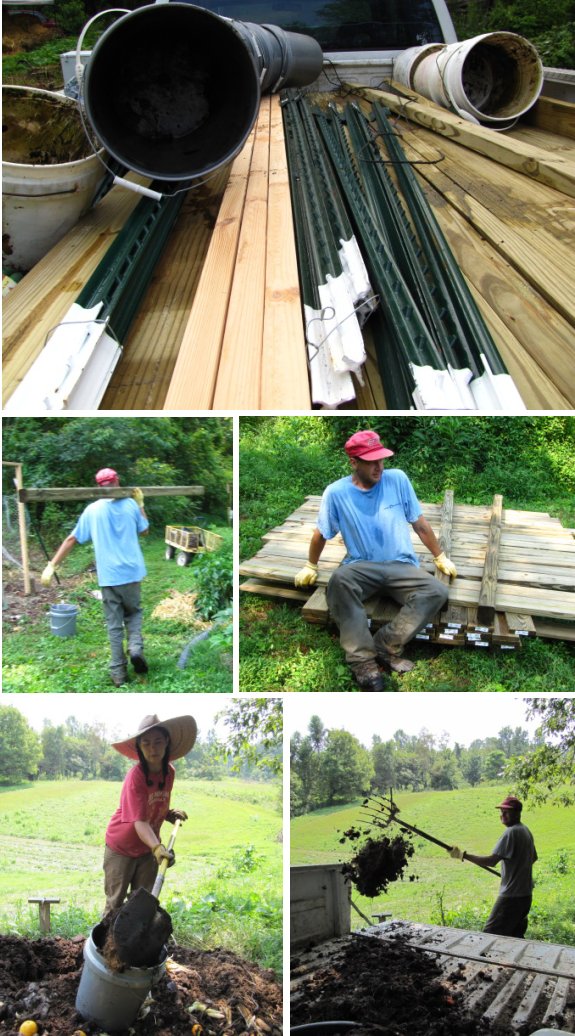
Today was just dry enough to
allow a few trips in the truck back to the trailer.
We managed to unload a truck
full of lumber, made a much needed trash haul to the dump, and filled
up on manure.
I must say today was a good
day.
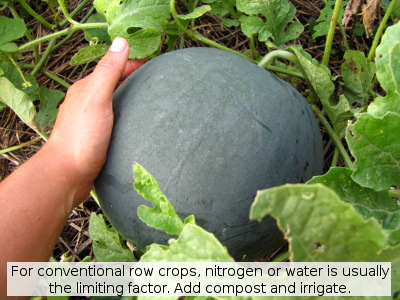 Whenever
I read permaculture-related books, I see great ideas that I can't
resist putting into practice. Some of them have amazing results,
but half or more fail miserably. Are the authors of the books
merely book learners who haven't tried out their ideas on the
ground? Sometimes. But more often, they simply fail to
mention their specific growing conditions and I forget to think about
how the ideas might mesh with my own site.
Whenever
I read permaculture-related books, I see great ideas that I can't
resist putting into practice. Some of them have amazing results,
but half or more fail miserably. Are the authors of the books
merely book learners who haven't tried out their ideas on the
ground? Sometimes. But more often, they simply fail to
mention their specific growing conditions and I forget to think about
how the ideas might mesh with my own site.
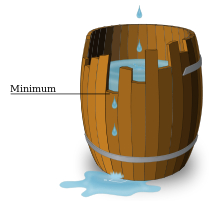 Limiting
factor is a useful ecological concept to understand when deciding
whether new ideas are worth trying in your garden. Unless you're
growing your
plants hydroponically under lights in climate-controlled conditions,
there's going to be some factor that keeps the crops from achieving
their full potential. The scientist who came up with the concept
of limiting factors used the illustration of a broken barrel to help
others visualize what he was talking about. No matter how much
water you pour into the barrel, it will only fill to the level of the
lowest stave --- the barrel's limiting factor.
Limiting
factor is a useful ecological concept to understand when deciding
whether new ideas are worth trying in your garden. Unless you're
growing your
plants hydroponically under lights in climate-controlled conditions,
there's going to be some factor that keeps the crops from achieving
their full potential. The scientist who came up with the concept
of limiting factors used the illustration of a broken barrel to help
others visualize what he was talking about. No matter how much
water you pour into the barrel, it will only fill to the level of the
lowest stave --- the barrel's limiting factor.
The most common
limiting factor for companion planted crops (and the
one that's
assumed by default in forest gardening literature) is light --- if you
plant peppers under your apple trees, the peppers will be puny because
the tree leaves steal their sunlight. In the conventional
vegetable garden, nitrogen is often assumed to be
the limiting factor since
that macronutrient can quickly wash out of the soil and since plants
won't grow much at all if faced with a nitrogen
deficiency.
Other common limiting
factors include all of the macro- and micronutrients,
water, growing
season length, cold, and heat.
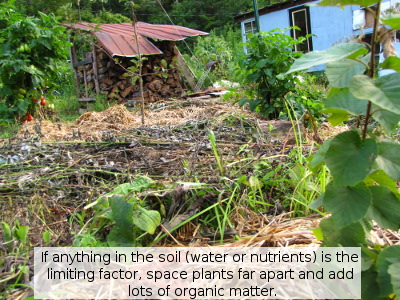 In the eroded
soil of our forest garden, the limiting factor is
unusual
--- depth
of topsoil/dry soil. Once I figured out my limiting factor, I had
more of a handle on guessing which permaculture tricks were likely to
work for me.
Growing plants in the understory beneath my fruit trees is bad news in
the forest garden because these plants will compete with my trees for
the most limiting resource --- soil --- and will slow the trees' growth.
In the eroded
soil of our forest garden, the limiting factor is
unusual
--- depth
of topsoil/dry soil. Once I figured out my limiting factor, I had
more of a handle on guessing which permaculture tricks were likely to
work for me.
Growing plants in the understory beneath my fruit trees is bad news in
the forest garden because these plants will compete with my trees for
the most limiting resource --- soil --- and will slow the trees' growth.
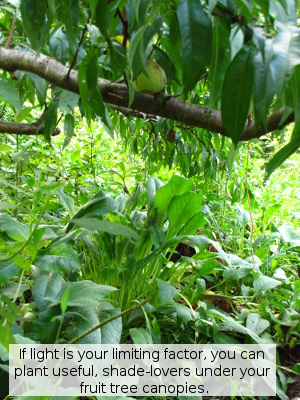 In my kitchen peach's forest
garden island, on
the other hand, the soil
is prime, so the limiting factor is light. I'm able to grow
hungry comfrey directly under the peach's canopy with no ill effects
because there are lots of nutrients and soil space to go around and the
tree shades the comfrey enough that the understory plant doesn't
provide much competition. Instead, comfrey helps out here by
pulling micronutrients up from the subsoil to feed to the peach when
the comfrey leaves decay. Even the volunteer butternut that
showed up in the topdressed compost seems to be thriving beneath the
kitchen peach.
In my kitchen peach's forest
garden island, on
the other hand, the soil
is prime, so the limiting factor is light. I'm able to grow
hungry comfrey directly under the peach's canopy with no ill effects
because there are lots of nutrients and soil space to go around and the
tree shades the comfrey enough that the understory plant doesn't
provide much competition. Instead, comfrey helps out here by
pulling micronutrients up from the subsoil to feed to the peach when
the comfrey leaves decay. Even the volunteer butternut that
showed up in the topdressed compost seems to be thriving beneath the
kitchen peach.
If you're growing on new
ground and don't know what your limiting factor is yet, you could do
worse than follow Sara's lead. She plants a
vegetable garden in a new spot every year, adding soil amendments and
learning what makes that plot of ground tick. By the time she's
ready to plant perennials that winter, Sara knows the best spots most
likely to keep those expensive fruit trees alive, and she's also
improved the soil enough to give them a head start. Now that's
permaculture in action!
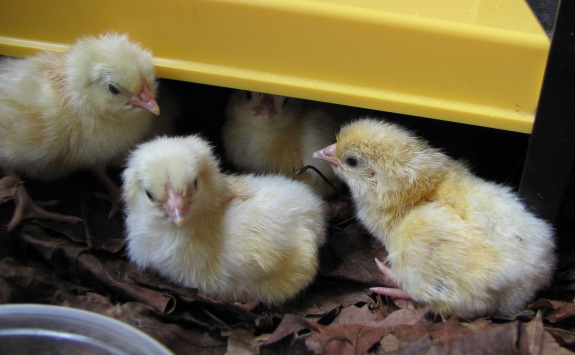
We've had a batch of eggs in
the incubator that started peeping yesterday and of course waited till
the wee hours of this morning before feeling ready enough to hatch.
Light Sussex is a new breed
for us. A classic British barnyard bird that seems to be less groggy on
day one than the other chicks we've hatched this year.
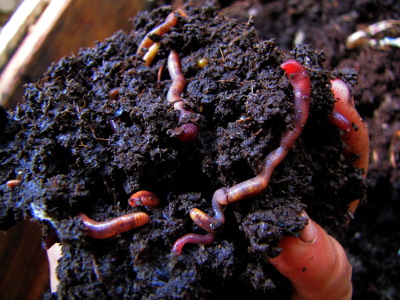 So,
I got busy and forgot to check on our worm bin for...three months.
So,
I got busy and forgot to check on our worm bin for...three months.
To keep you all up to
date, we started a medium-size
worm bin in February and filled it
with around 9 pounds of worms, shredded paper bedding, and then lots of
food
scraps from the local middle school. Throughout February,
March, and April, we layered food scraps between shredded paper, torn
cardboard, and pieces of cardboard egg cartons, until finally calling
the experiment a failure. The trouble is that
the worms just weren't happy with their  environment so they didn't
eat. Pests moved in and the whole thing stunk.
environment so they didn't
eat. Pests moved in and the whole thing stunk.
In May, I tossed twenty
gallons of horse manure into the bin to see how the worms would like
the alternative food. They loved it! If I'd gotten smart,
I would have added more manure immediately, but instead I got busy and
forgot about the bin.
When I finally looked
in, I was interested to see that the worms had completely composted all
of the manure and had finally started working on the food scraps.
The cardboard had 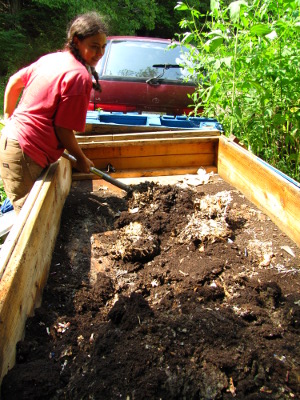 completely decomposed, but
there were still big chunks of paper present --- clearly, shredded
paper is not the best bedding material, even though it looks
like it should be. The worms seemed to have run out of food that
made them happy too --- I estimate that only about 4.5 pounds of worms
remained in the bin.
completely decomposed, but
there were still big chunks of paper present --- clearly, shredded
paper is not the best bedding material, even though it looks
like it should be. The worms seemed to have run out of food that
made them happy too --- I estimate that only about 4.5 pounds of worms
remained in the bin.
I shoveled all of the
worm castings to one side and Mark helped me fill the rest of the bin
mostly up with new horse manure. Hopefully the worms will all
migrate to the prime food and I'll be able to use the finished worm
castings on our fall garden and potted plants. I estimate the
total production from 270 pounds of food scraps, 20 gallons of manure,
and masses of bedding is about 8 cubic feet (0.3 cubic yards or 60
gallons) --- vastly less than I'd expected, but probably still enough
to have positive effects on the garden.
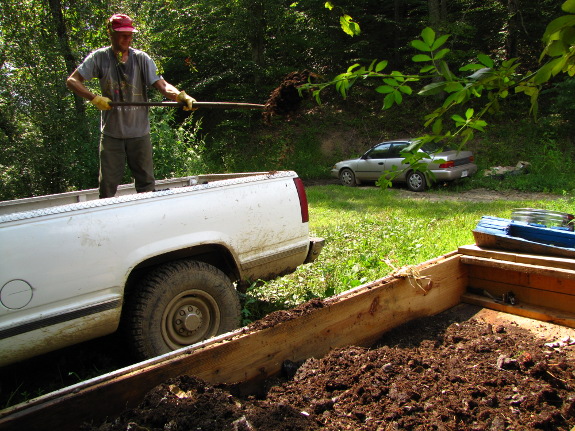
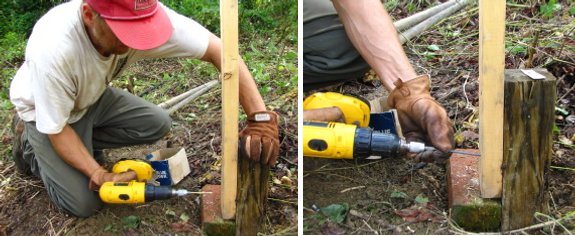
Chicken
pasture #6 is about half
way done, but instead of finishing it this week we decided to start
pasture #7.
With any luck pasture #7 will
block an obvious deer path and maybe steer those midnight snackers
toward some other part of the forest.
We didn't have a proper post
to build a gate frame on, so I used a combination of scrap 4x4's, old
bricks, and a 2x4 to make what seems like a solid enough structure.
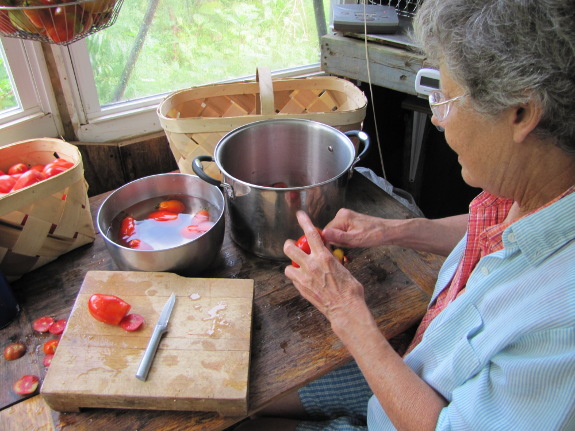
There are a few
homesteading projects I consider important enough to make the cut for
Weekend Homesteader but which I don't personally undertake very
often. The first one was the rain barrel project in the May
volume (which seems
to have started me thinking about rain barrels --- stay tuned for more
on our upcoming rain collection experiment.) The next was canning.
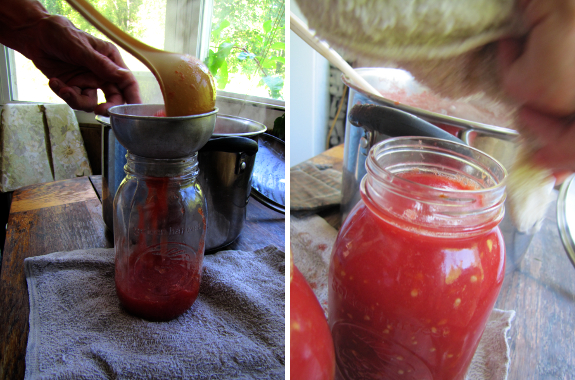
I've canned tomatoes and
applesauce a couple of times before, but I'm not a big fan of the
preservation technique. You have to save up masses of food and
process it all at once, and I just don't think that most foods taste
very good canned. (Tomatoes and apples are the sole
exception.) On the other hand, knowing how to can is a good skill
for any homesteader to have since you don't need to use electricity and
the result will last for multiple years. Plus, canning is so
archetypal that if I asked ten artists to draw a picture of
homesteading, five of them would probably protray canning.
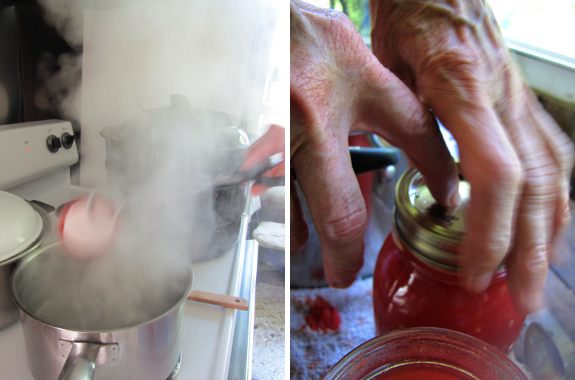
I asked Mom to come over
and help me preserve a load of tomatoes to refresh my memory before
writing up the project for Weekend Homesteader: September. I'm so
glad I did! She bubbled over with so much enthusiasm and
knowledge that I could tell canning had been one of her favorite parts
of living on the land.
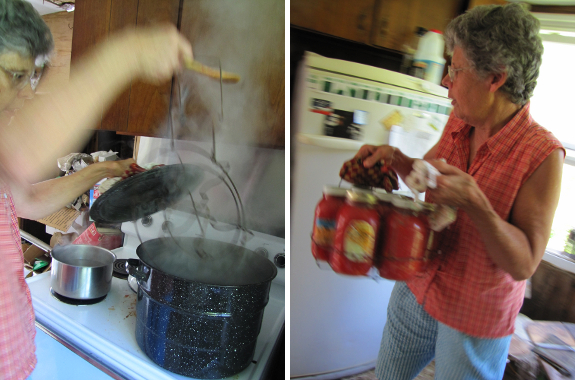
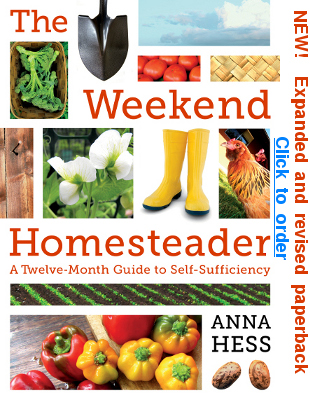 I know several people
who can masses of garden produce every year...then don't eat any of
it. After canning with a passionate expert, I understand how the
process could turn into a fun hobby even if you don't like the taste of
the results. The boiling water gets your adrenaline pumping, the
reflective glass and colorful produce sates your eyes, and canning is a
perfect bonding experience if you bring your mom along. Thanks
for doing all the heavy lifting, Mom!
I know several people
who can masses of garden produce every year...then don't eat any of
it. After canning with a passionate expert, I understand how the
process could turn into a fun hobby even if you don't like the taste of
the results. The boiling water gets your adrenaline pumping, the
reflective glass and colorful produce sates your eyes, and canning is a
perfect bonding experience if you bring your mom along. Thanks
for doing all the heavy lifting, Mom!
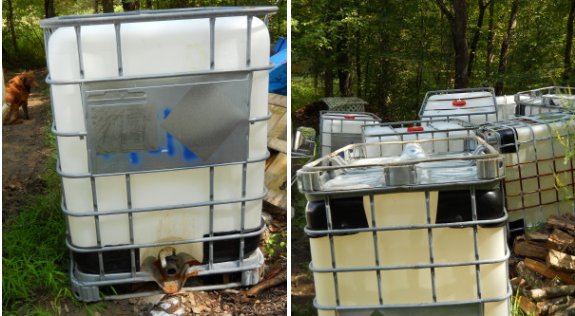
Anna noticed these used tanks
for sale in a neighbor's yard last week and asked me to investigate.
They all seemed to be in good
shape. I worked out what I think was a pretty good deal with the guy to
buy all 7 for 25 dollars each. As a bonus he delivered them at no extra
charge. An extra bonus was meeting yet another nice neighbor in the
community.
I'm sure there'll be more than
one permaculture experiment we can think of to make use of these
intermediate bulk container tanks.
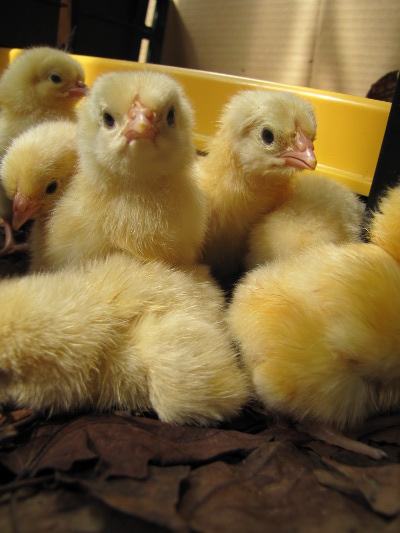 I
feel like our four incubator runs this year have equated to a semester
of Incubation 101, which would make this last hatch the final
exam. Good thing I get to write a blog post full of pictures
instead of a term paper!
I
feel like our four incubator runs this year have equated to a semester
of Incubation 101, which would make this last hatch the final
exam. Good thing I get to write a blog post full of pictures
instead of a term paper!
We hatched 14 very perky
chicks out of 24 eggs this time around. A 58% hatch
rate from mail
order eggs is above
average, so I'll give myself a B+ based on pure math.
Now that the normal
progression of pipping to unzipping to hatching is firmly ingrained
in my memory, I barely worried about the incubation process (although I
have to admit I woke up to peer into the incubator with the flashlight
when the chicks all started popping out of their shells in the middle
of the night.) I helped
one chick a bit
prematurely, then waited a long time to help another chick who might
have needed assistance (but who hatched on his own eventually), and yet
both of those troublesome chicks are now indistinguisable from their
brethren. I guess that's a B on grasping the gestalt of the hatch.
 Now that I've settled on an
incubator that really does the job, I can start learning the
ideosyncracies of my equipment. For example, is it coincidental
that eggs in the center of the incubator tray are less likely to hatch
than those on the edges and tend to hatch later? I only kept data
on egg location for two hatches and both showed the same trend, but I
just don't have enough data points to know for sure. And if that
is indeed the case, what could I do about it to improve my hatch rate
--- move eggs around in the incubator every few days, perhaps?
Now that I've settled on an
incubator that really does the job, I can start learning the
ideosyncracies of my equipment. For example, is it coincidental
that eggs in the center of the incubator tray are less likely to hatch
than those on the edges and tend to hatch later? I only kept data
on egg location for two hatches and both showed the same trend, but I
just don't have enough data points to know for sure. And if that
is indeed the case, what could I do about it to improve my hatch rate
--- move eggs around in the incubator every few days, perhaps?
And I wonder why the
majority of my eggs always seem to hatch on day 22 instead of the
stereotypical day 21. Should I be running the incubator a bit
hotter than 99.6 even though it's a forced air model? Or am I
just counting wrong --- is the day I turn on the heat considered day 0
instead of day 1?
I guess I'll learn these
more advanced tricks in Incubation 202, offered spring 2012. If
you want to brush up on your early incubation skills, you might be
interested in checking out my other chicken
incubation posts on
our chicken blog.
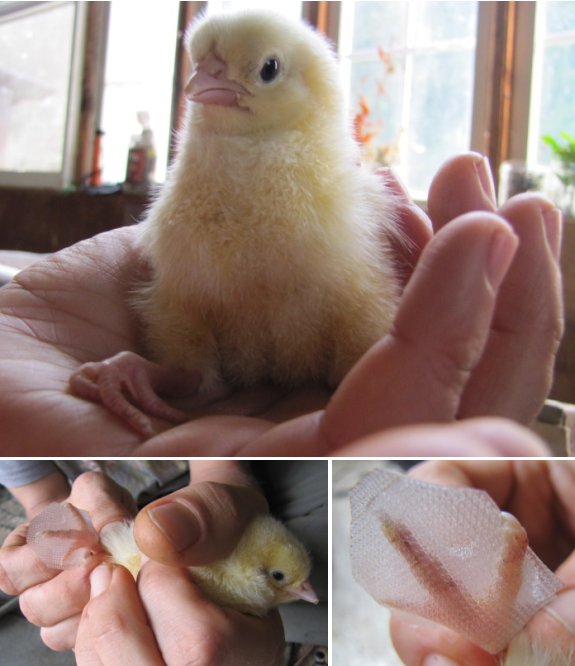
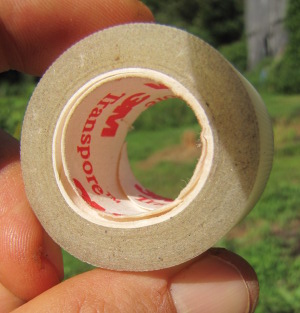
One of our Light
Sussex chicks took a little longer fighting his way out of the egg
and somehow didn't get to extend his toes on his right foot.
We had some good luck
fabricating a splint with a small piece of 3M Transpore tape.
I think it's going to work.
He pecked at it for a few minutes, and then the other chicks pecked at
it for a while and then stopped.
Want
to save your cucumber seeds so you don't have to buy them next
year? The first step is to let one of your cucumbers grow bigger
and bigger until it turns yellow.
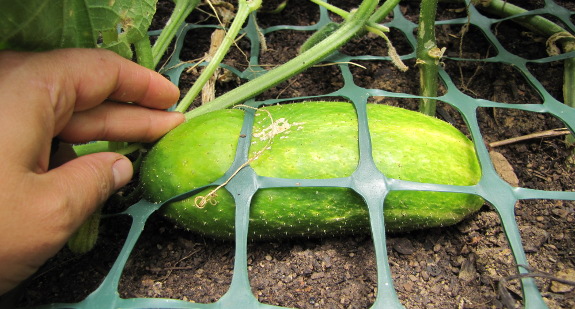
Not quite....
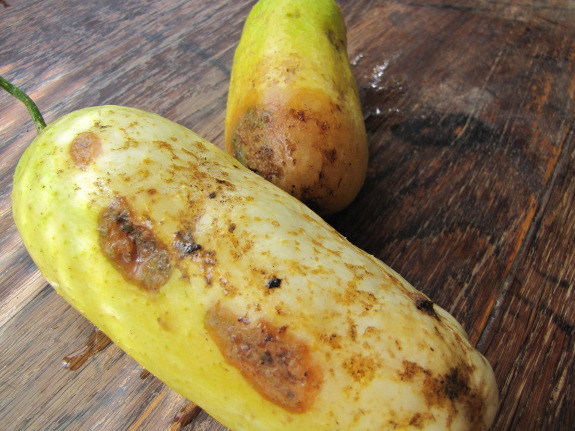
Now they're ready!
For best results, let each cucumber sit for a week after removing it
from the vine, then...
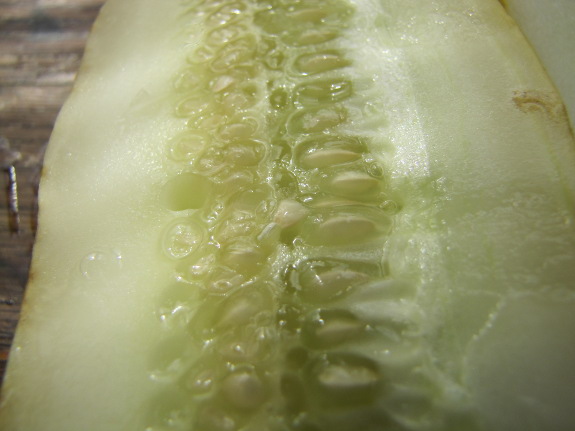
...slice the cucumber in
half...
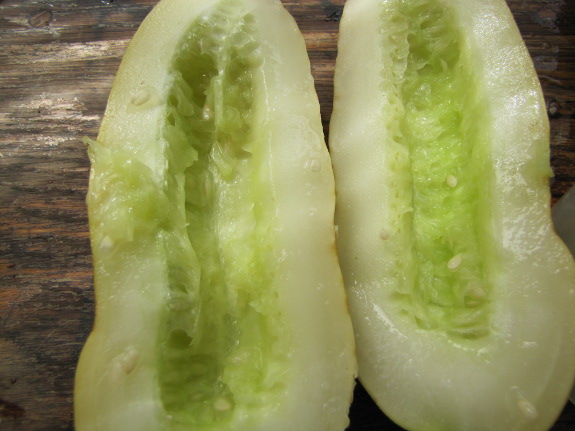
...and pull out the guts
with your finger.
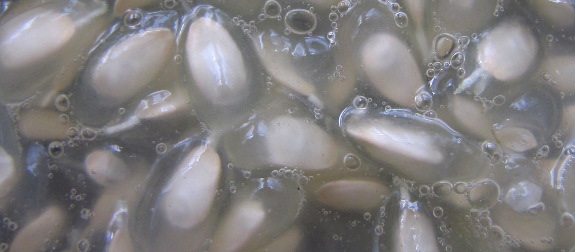
The seeds are enclosed
in little sacs of gel, which is a clue that
they're not ready to dry as is. First you need to ferment the gel
sacs off the way you do when saving
tomato seeds.
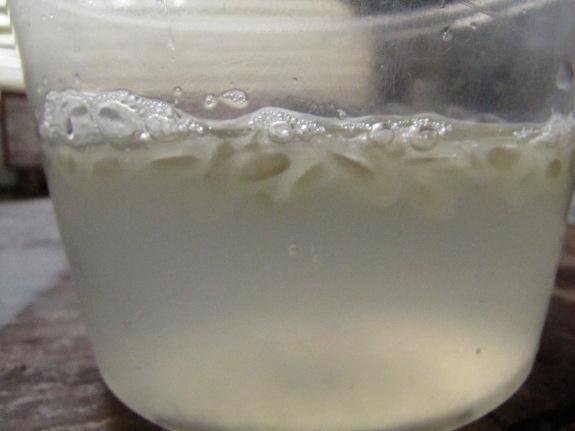
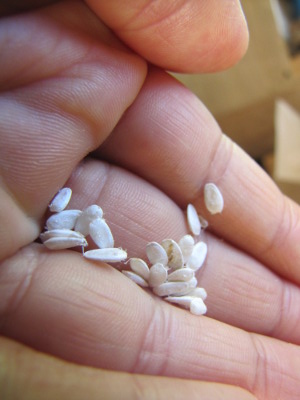 Just pour some water into the
container with your cucumber seeds and
ignore the cup for a few days until all the seeds fall to the
bottom. You may need to stir gently with a spoon to make the
seeds drop out of suspension. Mold on top of the water is a good
sign, signalling that your seeds are ready, but a foul smell means you
waited too long. You can still harvest the seeds once the water
starts to stink, but your husband will (rightly) complain about the
noxious scent in the kitchen.
Just pour some water into the
container with your cucumber seeds and
ignore the cup for a few days until all the seeds fall to the
bottom. You may need to stir gently with a spoon to make the
seeds drop out of suspension. Mold on top of the water is a good
sign, signalling that your seeds are ready, but a foul smell means you
waited too long. You can still harvest the seeds once the water
starts to stink, but your husband will (rightly) complain about the
noxious scent in the kitchen.
Skim off the mold and
carefully pour off the water, then rinse the seeds a few
times. Finally, let the seeds dry and examine what you've
got. Many cucumber varieties (like the one I tried to save seed
from) are parthenocarpic, which means that the female flowers with
produce fruit without being fertilized by pollen from a male
flower. Parthenocarpic cucumbers are great in the garden since
they tend to produce fruits earlier than other varieties, but these
cucumbers' seeds will end up looking like the ones shown here --- very
flat and small and not viable. I guess I need to find another
variety of cucumber if I want to save the seeds!
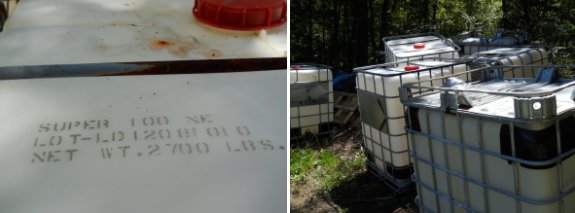

Anna examined our new
intermediate bulk containers a bit more closely and discovered a
stencil printed on the top which describes the containers' original
content.
Super 100 NE contains only
two ingredients designated as hazardous. Isopropyl Alcohol and Glycol Ethers.
A quick google search reveals
that Super 100 NE has a strong smell. The plan is to give each tank a
smell test, and if we detect anything we'll keep rinsing it out till
the odor is gone.
I guess it would've been
smart to do this homework before I bought the things. I doubt if it
would have been worth it to mess with something chemically dangerous to
the point of being a "severe" health hazard.
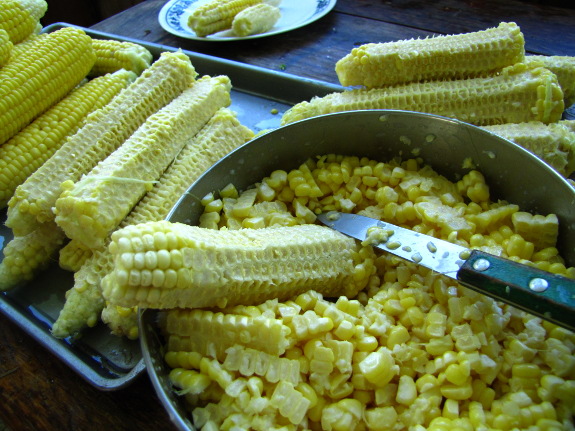
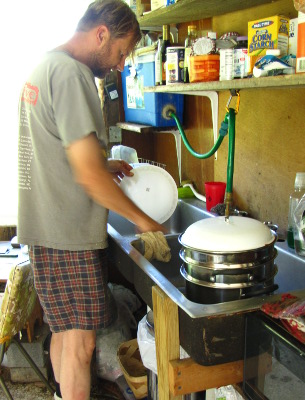 Sometime
in early to mid August, the flow of food from garden to table becomes a
flood. Nowadays, my farm chores are often done in the kitchen, blanching
beans, cutting corn off the cob, and stewing up a pot of soup.
The garden still needs work, of course, but my priorities have shifted
to making sure we have enough bounty preserved to enjoy throughout the
winter months.
Sometime
in early to mid August, the flow of food from garden to table becomes a
flood. Nowadays, my farm chores are often done in the kitchen, blanching
beans, cutting corn off the cob, and stewing up a pot of soup.
The garden still needs work, of course, but my priorities have shifted
to making sure we have enough bounty preserved to enjoy throughout the
winter months.
Poor Mark has to deal
with the consequences. It's not unusual for a preserving endeavor
to conclude with both sink basins and the counter stacked over a foot
high with dirty pots and pans, so I sometimes take pity on him and
recommend that he use some of our "work hours" to deal with the
mess. Cooking and dishes count as a farm chore at this time of
year!
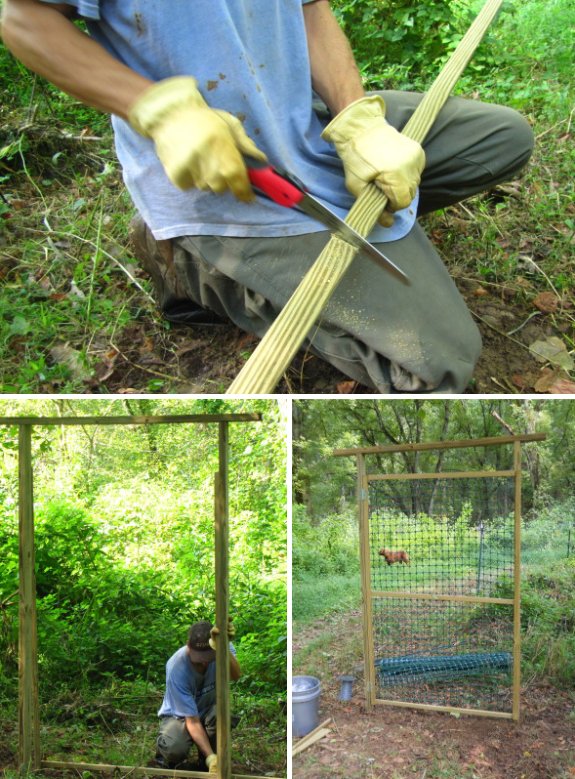
I think I've found an easier
way of making a gate frame for our chicken
pastures.
Each side piece is a standard
8 foot long treated 2x4 that gets sunk in the ground at a depth of
about 19 inches. The top piece is cut to a 5 foot length.
Treated furring strips
attached in a rectangle shape make a good gate that's light weight and
low budget. I'm guessing the total price for this project is somewhere
between 15 and 20 dollars. Not sure what the longevity will
be like, but I'm thinking it might be comparable to a cedar post. I
guess I'll know the answer in another 10 to 30 years.
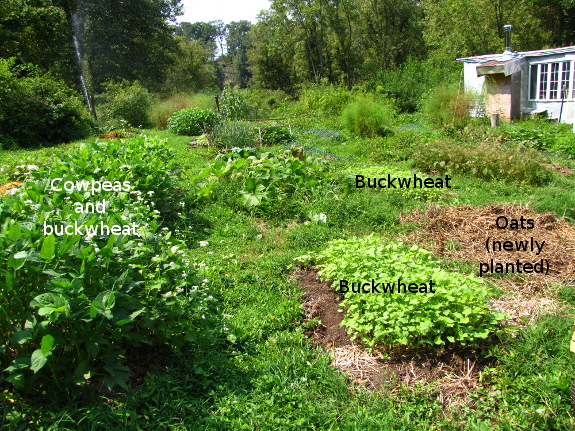
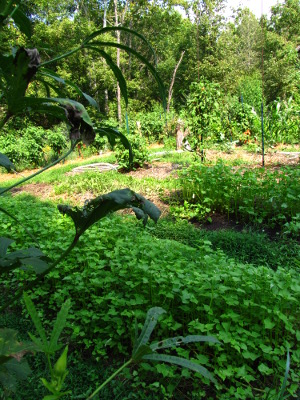 I've been very surprised by
how many cover crops I was able to slip into the garden this year
without adding any extra growing area or putting in fewer table
crops. I never felt like I was leaving beds empty in
previous years (except in the winter), but I often had to save a bed
for a month or two for succession planting of summer crops or for fall
garlic. This year, I filled those gaps with buckwheat
and/or cowpeas and was surprised to realize my plantings ended up
treating a quarter of the garden without specifically setting aside
beds to stay fallow.
I've been very surprised by
how many cover crops I was able to slip into the garden this year
without adding any extra growing area or putting in fewer table
crops. I never felt like I was leaving beds empty in
previous years (except in the winter), but I often had to save a bed
for a month or two for succession planting of summer crops or for fall
garlic. This year, I filled those gaps with buckwheat
and/or cowpeas and was surprised to realize my plantings ended up
treating a quarter of the garden without specifically setting aside
beds to stay fallow.
Meanwhile, I'm already
seeding oats
and oilseed radishes
into beds that I know I won't use again until 2012. Buckwheat is
nice, but the fall cover crops are the real winners, adding much more
organic matter, cutting down on weeds (meaning less work in the
spring), and keeping the garden vibrant during what used to feel like
the downward slide of the garden year. I have to admit, 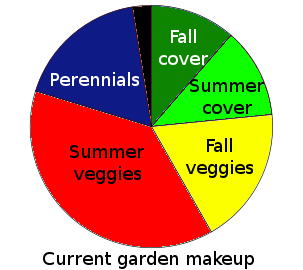 though, that the best part
about winter cover crops is that there's a relatively narrow window in
which I can plant them --- September 15 is the bitter end for the ones
I've found will reliably winterkill --- so I'm forced to keep the
garden "clean", pulling up that sweet corn and those buggy beans as
soon as they stop producing. An eighth of the garden is now under
winter cover, which means I don't have to touch those beds again until
spring --- how restful is that?
though, that the best part
about winter cover crops is that there's a relatively narrow window in
which I can plant them --- September 15 is the bitter end for the ones
I've found will reliably winterkill --- so I'm forced to keep the
garden "clean", pulling up that sweet corn and those buggy beans as
soon as they stop producing. An eighth of the garden is now under
winter cover, which means I don't have to touch those beds again until
spring --- how restful is that?
I thought you might
enjoy seeing a mathematical snapshot of our garden (minus the woody
perennials). Looks like I have four empty beds --- shame on me!
The first curled
toes splint we did on Monday could have been better. We fixed it
first thing Tuesday morning with a fresh splint that didn't let any
part of the toe show.
We looked at it this morning
and decided his toes were flat enough to scamper around without a brace.
It seems to be working. It's
already difficult to single him out of the crowd now that he's not
wearing that 3M Transpore chick toe splint.
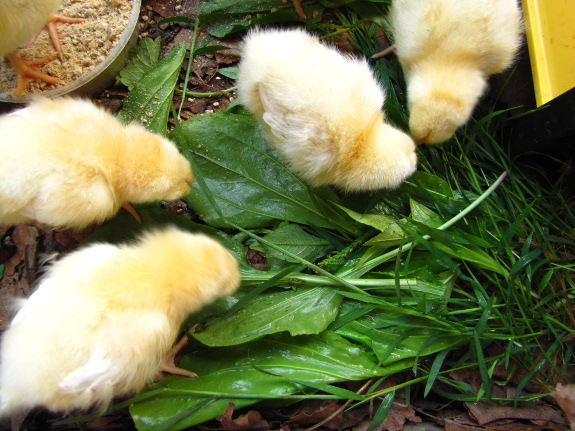
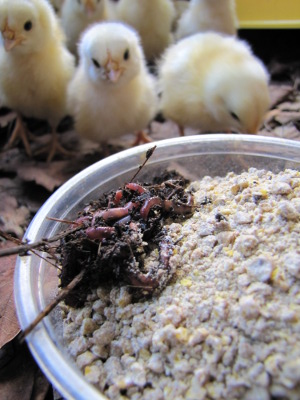 Our Light
Sussex chicks eat
like crazy, so I decided that six days was plenty old enough to try
them out on forage. I don't want to put the chicks on pasture yet
for fear of predators snagging such tender morsels, so instead I
brought the pasture to them.
Our Light
Sussex chicks eat
like crazy, so I decided that six days was plenty old enough to try
them out on forage. I don't want to put the chicks on pasture yet
for fear of predators snagging such tender morsels, so instead I
brought the pasture to them.
First try was some
compost worms dug out of the worm bin. I figured redworms
might be small enough for a tiny chick to handle, and I've seen our
mother hen feed her chicks worms at this age. But while our
chicks were interested and carried the worms all over the brooder, I
don't think they managed to consume any. Maybe the mother hen
breaks the worms into smaller pieces?
Next, I brought in a
weed bouquet. Our adult chickens love broad plantain, clover, and
sourgrass, so I included them all (along with some grass and violets
that came along for the ride.) The chicks might have eaten some
of the plantain seeds --- it was tough to tell whether 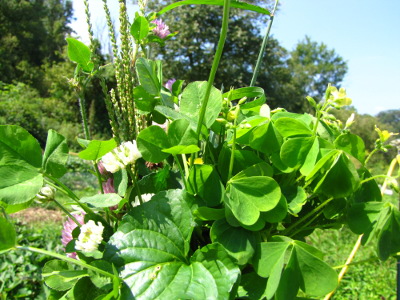 they
managed to peck any out in the midst of the melee --- but what they
were clearly consuming with great pleasure was the sourgrass buds,
flowers, and flowering stems. Looks like there's at least
something fresh that motherless chicks can eat by their lonesome.
they
managed to peck any out in the midst of the melee --- but what they
were clearly consuming with great pleasure was the sourgrass buds,
flowers, and flowering stems. Looks like there's at least
something fresh that motherless chicks can eat by their lonesome.
Modern chicken-keeping
books warn you not to feed your chicks too much greenery at a tender
age, but such advice smacks of doctors scaring young mothers away from
breast-feeding for fear of malnourishing their babies. In
contrast, the hundred-plus year old chicken books I've been perusing
this year stress the importance of fresh forage for chickens of all
ages. Hopefully a few more weed bouquets will get our chicks in
foraging mode before I turn them onto pasture.
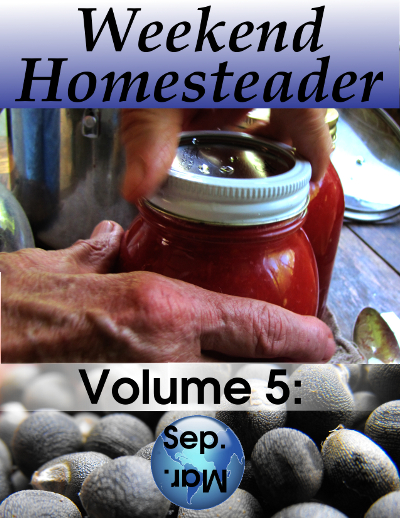 September
is peak harvest time on the homestead. This
volume of Weekend
Homesteader focuses
on the garden bounty as you learn to spice up your
cooking, can tomatoes for the winter, and save seeds for next year's
garden. Meanwhile, our teamwork exercise is a restful interlude
from the hard culinary and horticultural work.
September
is peak harvest time on the homestead. This
volume of Weekend
Homesteader focuses
on the garden bounty as you learn to spice up your
cooking, can tomatoes for the winter, and save seeds for next year's
garden. Meanwhile, our teamwork exercise is a restful interlude
from the hard culinary and horticultural work.
For those of you who are new to Weekend Homesteader, this series walks
you through the basics of growing your own food, cooking the bounty,
preparing for
emergency power outages, and achieving financial independence.
I hope you'll consider
splurging 99 cents to buy
a copy of my newest ebook from Amazon's
Kindle store. Your purchases (and extremely helpful reviews!)
allowed last month's ebook to pop into the top 1% of all Amazon ebooks,
which has helped it see the light of day beyond readers of this
blog. Weekend
Homesteader: August
has found its way onto 239 kindles already, which encourages me to keep
writing.
 As usual, I'm also very
glad to email you a free pdf copy to read if you
don't have the spare cash, or just don't want to deal with downloading
an app so you can
read the ebook on your computer or phone. Just email
me with your request --- no strings attached.
As usual, I'm also very
glad to email you a free pdf copy to read if you
don't have the spare cash, or just don't want to deal with downloading
an app so you can
read the ebook on your computer or phone. Just email
me with your request --- no strings attached.
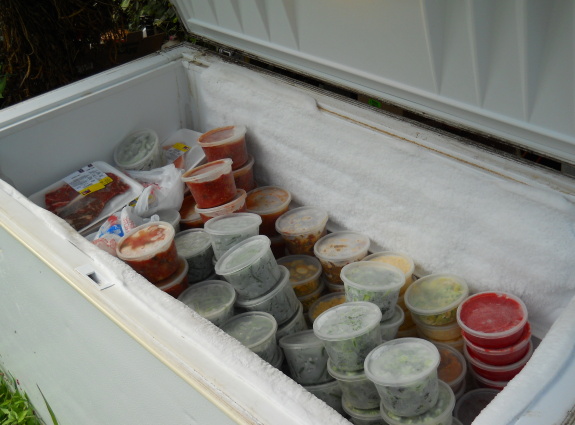
20 gallons of vegetables + a
misc amount of chickens and fruit = 2/3 of the way to our goal of
having enough garden goodies to get us through this upcoming winter
season.
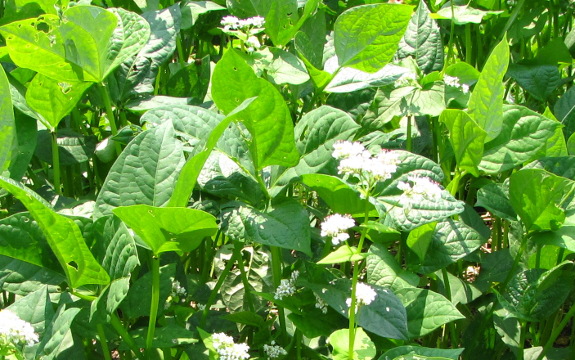
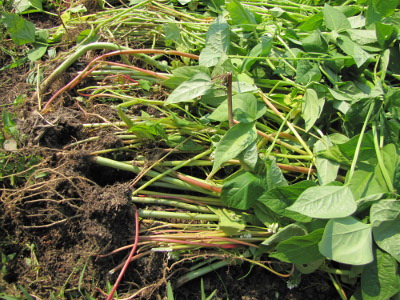 You may remember that I've
been experimenting with mixing
cowpeas in with my buckwheat cover crop this summer. Although
the cowpeas grew well, I'm not sure we'll plant them again next year
for a few different reasons.
You may remember that I've
been experimenting with mixing
cowpeas in with my buckwheat cover crop this summer. Although
the cowpeas grew well, I'm not sure we'll plant them again next year
for a few different reasons.
The obvious strike
against cowpeas is price. Our local feed store doesn't stock
cowpea seeds, and ordering cover crop seeds online is expensive.
Buckwheat seeds bought locally clock in at a bit over a dollar a pound,
but once you factor in shipping, cowpea seeds cost me about $2.40 per
pound even if you buy them in 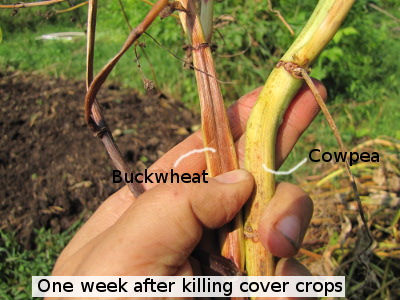 bulk. Now, to be fair,
the one pound of seed I bought (for $4.25 plus shipping) seeded 23 beds
in combination with buckwheat, which means that if I'd planted only
cowpeas in those beds, I would have been spending about 37 cents per
bed. That price tag compares very favorably to the roughly $1.33
per bed I would have spent on straw to mulch the beds down for the six
weeks between crops.
bulk. Now, to be fair,
the one pound of seed I bought (for $4.25 plus shipping) seeded 23 beds
in combination with buckwheat, which means that if I'd planted only
cowpeas in those beds, I would have been spending about 37 cents per
bed. That price tag compares very favorably to the roughly $1.33
per bed I would have spent on straw to mulch the beds down for the six
weeks between crops.
The next problem
is ease of killing. Cowpeas aren't nearly as hard to kill as the overwintering
grains I fought with this spring, but they do tend to
resprout if mow-cut. Even when I pulled up individual plants (a
method that turned out to be faster than mow-cutting), perhaps 10% of
the cowpeas survived to reroot. On the small scale I've been
experimenting with, this regrowth barely had an impact on my gardening
time, but I wouldn't want to have a large area planted in cowpeas.
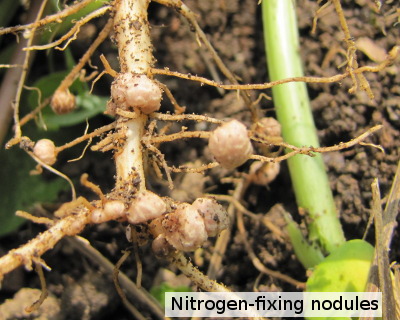 Finally, I was disappointed
by how long the cowpeas took to decompose. I'd read that cowpeas
have a very good C:N ratio of 21, compared to the not-so-shabby C:N of
34 for buckwheat.
Those numbers mean that cowpeas should break down even faster than
buckwheat and be ready to plant into quickly. However, when I
pulled up beds of cowpeas and buckwheat a week before planting and laid
the plants on the soil surface to die, the buckwheat leaves were
completely gone and the stems were halfway decomposed by planting
time. In contrast, the cowpea leaves were still somewhat visible
and the stems were thick and green. Again, since I was
experimenting on a small scale, it was no big deal to layer the cowpea
stems as a mulch around the edges of the garden beds, but on a larger
scale, I'd probably instead have to kill the cowpeas an extra two or
three weeks before planting into them. I guess cowpeas aren't
such a quick summer cover crop after all.
Finally, I was disappointed
by how long the cowpeas took to decompose. I'd read that cowpeas
have a very good C:N ratio of 21, compared to the not-so-shabby C:N of
34 for buckwheat.
Those numbers mean that cowpeas should break down even faster than
buckwheat and be ready to plant into quickly. However, when I
pulled up beds of cowpeas and buckwheat a week before planting and laid
the plants on the soil surface to die, the buckwheat leaves were
completely gone and the stems were halfway decomposed by planting
time. In contrast, the cowpea leaves were still somewhat visible
and the stems were thick and green. Again, since I was
experimenting on a small scale, it was no big deal to layer the cowpea
stems as a mulch around the edges of the garden beds, but on a larger
scale, I'd probably instead have to kill the cowpeas an extra two or
three weeks before planting into them. I guess cowpeas aren't
such a quick summer cover crop after all.
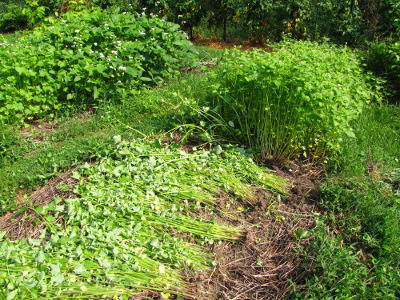 The good news is that I'm
learning to love buckwheat. My gut feeling last year was that
buckwheat didn't do much for the garden beds, but now that I've tried
the cover crop in non-waterlogged, more loamy portions of the garden,
I'm more impressed by this little producer. Filling
garden gaps with buckwheat certainly doesn't hurt the organic
matter content of the soil, and the bees definitely love them.
Next summer, it's going to be buckwheat all the way!
The good news is that I'm
learning to love buckwheat. My gut feeling last year was that
buckwheat didn't do much for the garden beds, but now that I've tried
the cover crop in non-waterlogged, more loamy portions of the garden,
I'm more impressed by this little producer. Filling
garden gaps with buckwheat certainly doesn't hurt the organic
matter content of the soil, and the bees definitely love them.
Next summer, it's going to be buckwheat all the way!
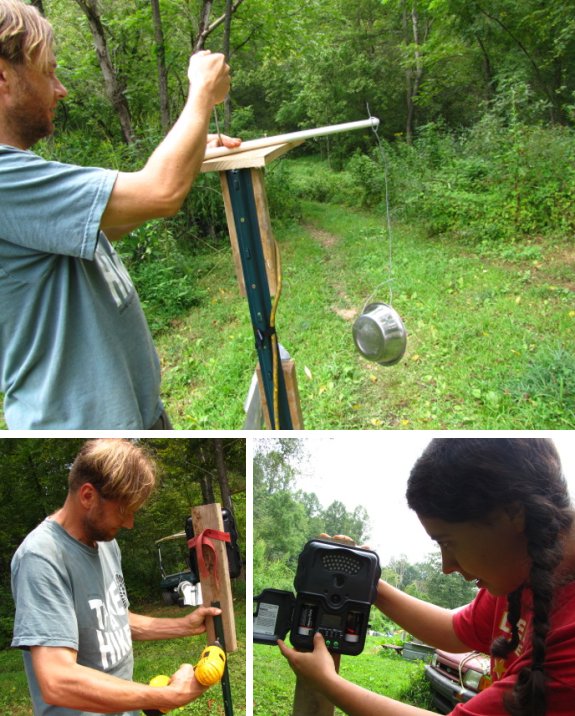
More deer damage last
night....but from a new direction down by the barn.
It might mean the recent chicken
pasture fence barrier is
actually making the deer change their daily route.
The latest incursion struck a
deep blow to what we thought was a protected area or at least a spot
that's made it the whole year without any deer nibbles.
We continue to deploy the mechanical,
non-lethal deer deterrent contraptions and added number 5 to the mix
this morning, but.....if that doesn't work the above trail camera
should give us some data on which way they're coming in from and at
what time. The logic is that maybe this particular deer has a window of
time when she stops in this area, and I'm not above a good old fashioned
ambush if that's what it's going to come down to.
 Your comments on my post
about Nigerian
dwarf goats were
extremely thought-provoking and helped us clarify our thinking.
Although the idea of goat milk is intriguing, I have to admit that the
real reasons I want to add an herbivore to the farm are (in order of
importance):
Your comments on my post
about Nigerian
dwarf goats were
extremely thought-provoking and helped us clarify our thinking.
Although the idea of goat milk is intriguing, I have to admit that the
real reasons I want to add an herbivore to the farm are (in order of
importance):
- Weed control --- We moved
all of our chickens from tractors to pastures last fall, which means a
lot of pastures to maintain. My observations suggest that the
optimal pasture for a chicken has a lot of tender herbaceous growth
close to the ground mixed in with trees and shrubs. However, what
our pastures want to turn into is thickets
of tall, herbaceous plants like ragweed, wingstem, virgin's bower,
and Japanese honeysuckle, all of which keep the tender growth out of
reach of chicken beaks. Yes, we can commit a few days a year to
weed whacking, but if we could get an animal to manage our pastures
while also producing useful products, how could we resist?
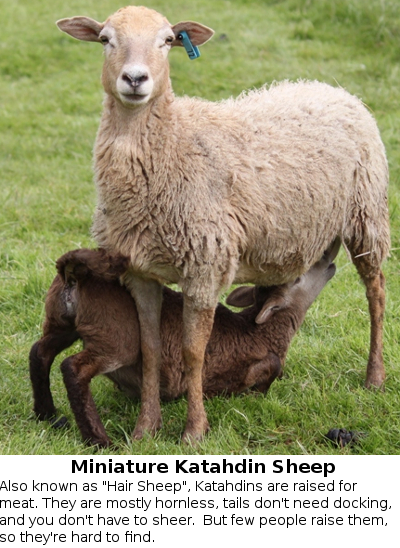 Meat --- Eating
pastured meat seems to be one of the keys to keeping my moods and
weight more in balance, but it's so expensive (and hard to find enough
from growers
you trust.) Any little bit we grow ourselves would help.
Meat --- Eating
pastured meat seems to be one of the keys to keeping my moods and
weight more in balance, but it's so expensive (and hard to find enough
from growers
you trust.) Any little bit we grow ourselves would help.- Manure --- Although we'll lose half or more of the manure to the pasture, if we make sure the livestock sleep inside at night on deep bedding, we'll be able to harvest considerable biomass for the garden.
Which all sent me
thinking back toward the livestock Mark and I had first talked about
years ago --- sheep. The trouble with ordinary sheep is that they
require a lot of space, having equivalent food needs to about 50 chickens or a
fifth of a cow apiece. Then there's the fact that sheep are fans
of grass, which makes them much less helpful since they wouldn't eat
the big weeds I'm looking to take out. But then I learned about
miniature sheep.
 Miniature sheep are a bit
less than half the size of ordinary sheep, which means we could
potentially keep a ewe, a ram, and their lamb on about a fifth of an
acre in our wet climate. If you pick and choose your variety
wisely, you can even find miniature sheep that have been bred to forage
well on forbs (non-grassy herbaceous plants like the ones overrunning
our pastures.)
Miniature sheep are a bit
less than half the size of ordinary sheep, which means we could
potentially keep a ewe, a ram, and their lamb on about a fifth of an
acre in our wet climate. If you pick and choose your variety
wisely, you can even find miniature sheep that have been bred to forage
well on forbs (non-grassy herbaceous plants like the ones overrunning
our pastures.)
I've included photos of
the varieties I find most intriguing (skipping miniature sheep that are
raised primarily for wool.) I'm leery of the Babydoll Southdowns,
even though they're the easiest to find, because I can't turn up any
information on their ability to graze on rough pasture and the name
makes me think they've been bred primarily as pets. Soay sheep
are intriguing but there's very little data about using them as meat
goats.
Miniature Katahdins are
near the top of my list because all of our neighbors raise the
full-size version and "Hair Sheep" seem to do very well in our climate
and on rough pastures. On the other hand, a quick search of the
internet turns up no local sources of the miniature variety.
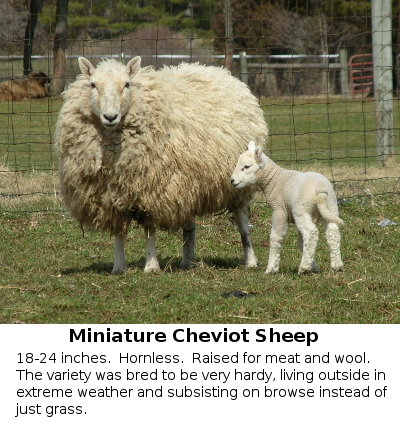 My next favorite is the
Miniature Cheviot, which is reputed to have been bred to survive on
Scottish moors with no shelter or supplemental food. Although
still not very common, there are two breeders within a long day's drive
of us, which makes the breed at least feasible.
My next favorite is the
Miniature Cheviot, which is reputed to have been bred to survive on
Scottish moors with no shelter or supplemental food. Although
still not very common, there are two breeders within a long day's drive
of us, which makes the breed at least feasible.
So what do you think
about miniature sheep? Have any of you had first hand experience
with the breeds I mentioned? Any other forb-foraging, meaty,
miniature sheep I should look into instead? Or should we change
our sights yet again to a different type of herbivore entirely?
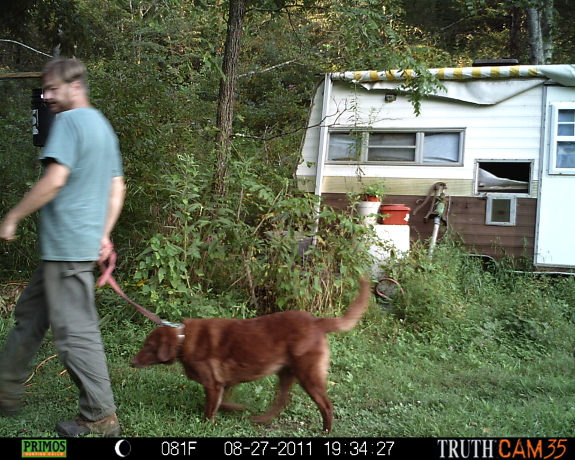

Not much hard evidence from
the trail camera last night but now we know it works and have a better
idea of the range.
Anna moved it this morning to what we think is where the deer came in
last night.
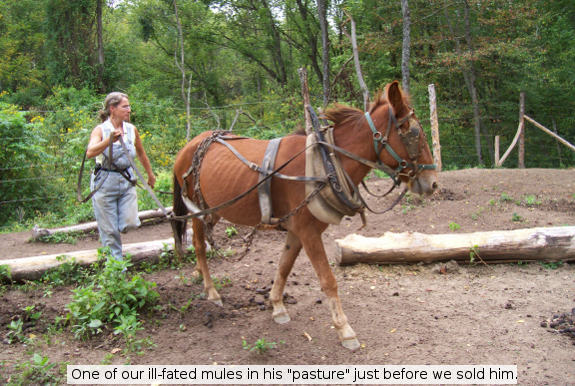
Years ago, we learned
the most important lesson of animal husbandry --- have sufficient
pasture before bringing your new livestock
home. But how many acres do you need for a sheep or goat or cow?
The trouble with
answering this question is that an arid pasture in the western U.S.
might support only a fifth as many animals per acre as a lush pasture
in the southern Appalachians. So animal scientists have come up
with what are known as "animal units" which compare all kinds of
different livestock to a 1,000 pound beef cow. An average
full-size sheep is 0.2 AU, which means you can keep five sheep in the
same space as the average beef cow. Here are some figures for
other livestock you might be interested in:
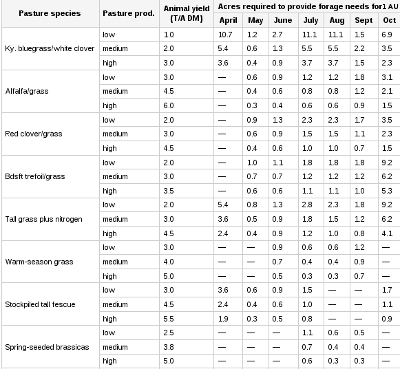 Mature bull - 1.5 AU
Mature bull - 1.5 AU- 450 pound calf - 0.5 AU
- Holstein cow - 1.5 AU
- Work horse - 2 AU
- Saddle horse - 1.25 AU
- Boar - 0.5 AU
- Brood sow - 0.25 AU
- 100 pound feeder pig - 0.05 AU
- Mature sheep - 0.2 AU
- Mature goat - 0.17 AU
- Roaster chicken (or, presumably, a layer) - 0.004 AU
- Heritage breed broiler chicken - 0.0025 AU
- Cornish cross chicken - 0.0015 AU
Within a species, you
can estimate that the amount of pasture an animal needs is roughly
proportional to how much it weighs. So, if you're pasturing
bantams, they'll need a good deal less pasture than for standard-sized
chickens, and ditto if you're raising miniature
sheep or dwarf
goats. The
figures I found on the internet suggest that an average Miniature
Cheviot sheep weighs about 43% as much as a full-size sheep, so each
one would be equivalent to 21.5 chickens instead of 50 chickens.
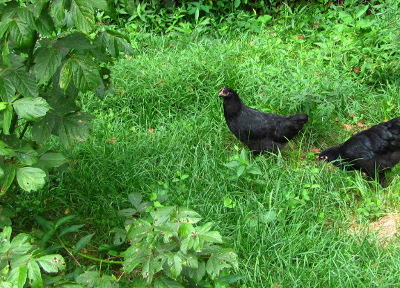 We've never raised cows on
our land, but I have figured out that our
chickens need at least 270 square feet apiece to keep from degrading
the pasture.
That means we should plan on at least 0.325 acres for a herd of 2.5
miniature sheep (mama, papa, and baby.) If we wanted to keep a
similar herd of full-size sheep, we'd need 0.75 acres fenced in.
And if we didn't want to give the sheep any supplemental feed in the
winter, we'd probably need to double those numbers.
We've never raised cows on
our land, but I have figured out that our
chickens need at least 270 square feet apiece to keep from degrading
the pasture.
That means we should plan on at least 0.325 acres for a herd of 2.5
miniature sheep (mama, papa, and baby.) If we wanted to keep a
similar herd of full-size sheep, we'd need 0.75 acres fenced in.
And if we didn't want to give the sheep any supplemental feed in the
winter, we'd probably need to double those numbers.
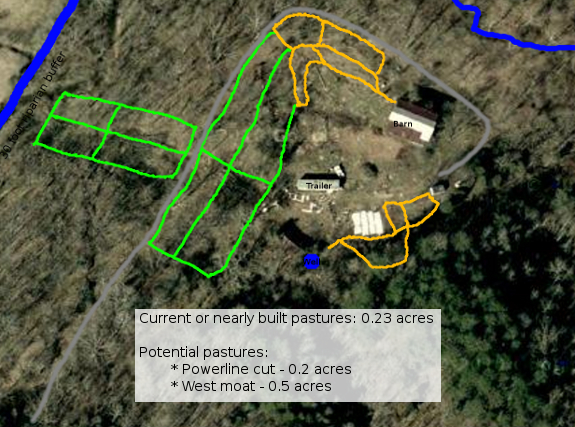
Mark's been building
pastures like mad all year, and if we finished up the two he recently
started, we'd already have almost a quarter of an acre fenced in.
Maybe miniature sheep wouldn't have to be pushed as far into the future
as I thought?
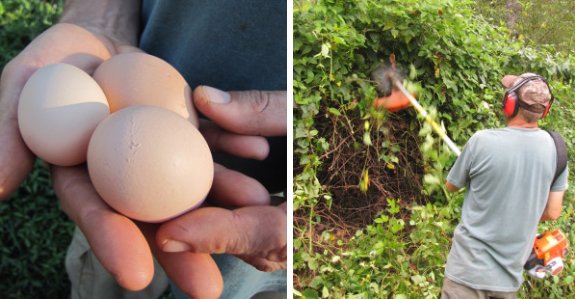
We got our first egg today
from the group we incubated and hatched back in the spring.
Feels like one of the signs
of Summer starting its long goodbye as it coincided with the first
morning it felt cold enough to wear long sleeves around here.
Thank you Summer....I know I
sometimes complained about all the extra rain you brought this year,
but I loved every wet minute of it and would like to take this moment
to express my deep felt gratitude for the wonderful
bounty we've already harvested. I look forward to seeing you again
next year.
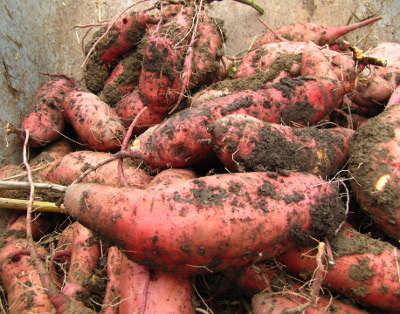 I've written before about when
to harvest sweet potatoes --- the short answer is, I
usually dig the tasty tubers sometime in late September. So why
am I pulling them out of the ground in August?
I've written before about when
to harvest sweet potatoes --- the short answer is, I
usually dig the tasty tubers sometime in late September. So why
am I pulling them out of the ground in August?
I've decided to cut our
losses with the sweet potatoes in the most deer-friendly spots.
After all, the tubers are used to store energy, and the plants need
energy to regrow leaves each time the deer invade. After a
certain number of defoliations, we'll actually get less tuber weight by
waiting than we could by digging now since the plants would use more
energy to regrow their leaves than they got back through photosynthesis
during these shortening days.
Okay, there's also the
fact that I had a nightmare about the deer digging my fall carrots out
of the ground with their hooves after being attracted to the sweet
potatoes. Who says I garden scientifically?
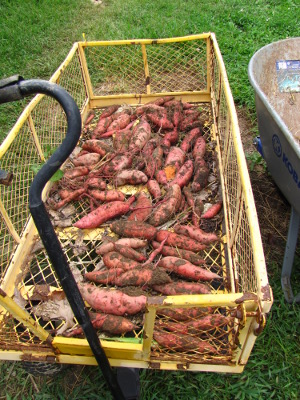 The tubers in the beds
planted on May 13 and 20 looked pretty much full-size, so I don't think
I lost too much by digging early. The mule garden bed, though,
was the last in --- planted on June 3 --- and clearly could have used
more time. Hopefully the four remaining beds --- two lightly deer
nipped and two protected by their proximity to our front door --- will
give us even bigger yields.
The tubers in the beds
planted on May 13 and 20 looked pretty much full-size, so I don't think
I lost too much by digging early. The mule garden bed, though,
was the last in --- planted on June 3 --- and clearly could have used
more time. Hopefully the four remaining beds --- two lightly deer
nipped and two protected by their proximity to our front door --- will
give us even bigger yields.
The one advantage of
harvesting some of our sweet potatoes early is that it allows me to
spread them out in the yellow wagon to cure. I always struggle to
find enough dry, shaded spots to set up screens during the curing
period, so it's great to be able to use a mobile drying station.
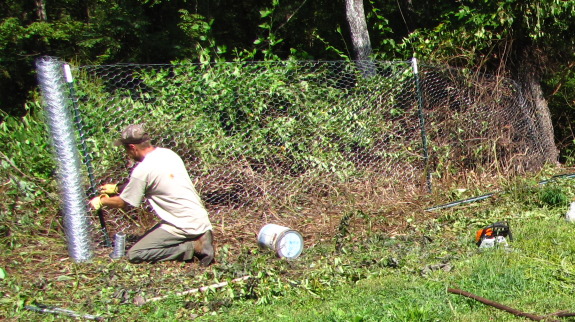
The deer snuck in again last
night and ate some swiss chard, which Anna says was a little buggy, so
no big loss there.
I managed to get another
stretch of 5 foot high chicken wire up.
It's starting to feel more
like a perimeter with this latest barrier.
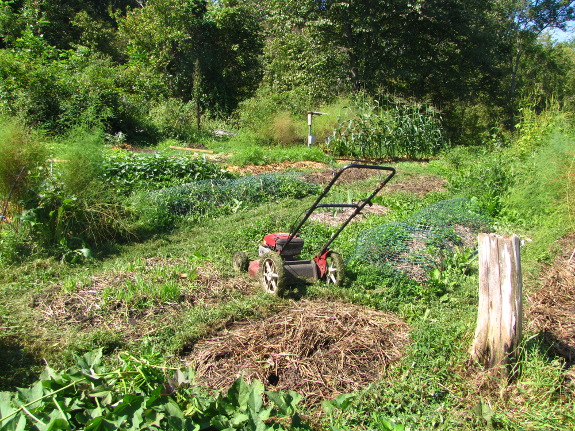
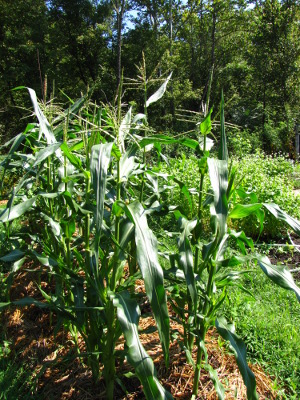 Corn is my summer garden
calendar. I plant
new beds of sweet corn every two weeks in spring and early summer,
but the harvests
don't come in two week intervals. Instead, cold soil slows the
growth of early beds, long days and hot weather speed up midsummer
corn, and then fall beds are stunted by shortening daylight.
Corn is my summer garden
calendar. I plant
new beds of sweet corn every two weeks in spring and early summer,
but the harvests
don't come in two week intervals. Instead, cold soil slows the
growth of early beds, long days and hot weather speed up midsummer
corn, and then fall beds are stunted by shortening daylight.
With only two plantings
of corn left in the garden, I know winter is coming. So does the
corn. Our latest planted corn is tassling short, bound and
determined to at least set some seeds before the frost. I tried
to explain that we still have six more weeks of summer, but the corn
wasn't listening.
I figured the corn had a
point, so I've been washing extra loads of laundry to take advantage of
the last of the summer heat. Winter blankets and coats are much
easier to
dry in August than they would be in November and it'll be nice to
go into cold weather with everything clean.
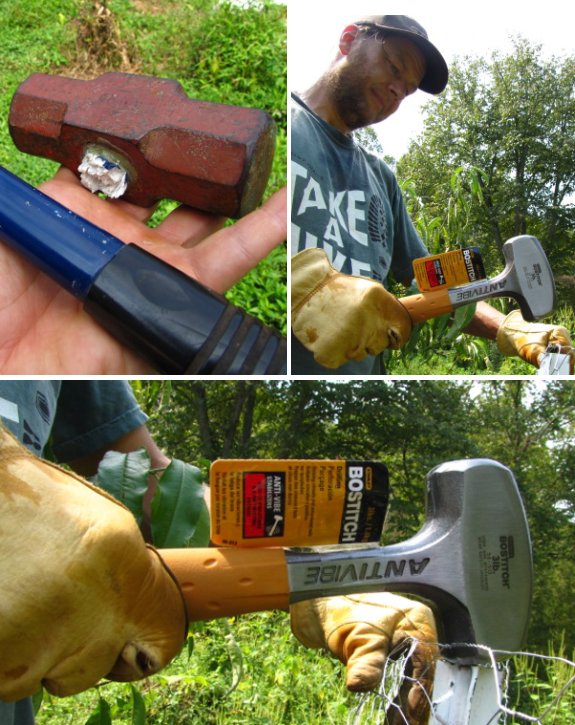
The second date Anna and I
went on was a trip to the local flea market where we bought a cheap
mini sledge hammer for 5 dollars about 7 years ago. It seemed like
a good deal at the time, but we've since learned that cheap tools are
often not cut out for serious homesteading work. In all fairness to the
makers in China the hammer in question did recieve some improper use
from a helper missing the post and hitting it with the handle, which
most likely contributed to it breaking the other day.
Sometimes a pole driver makes
hammering a T-post easier, which we might get in the future, but I've got
used to using a mini-sledge.
I doubt if the handle will
ever break on our new Stanley Bostitch Antivibe Hammer. It
feels more balanced compared to holding the other mini sledge and
pounds like a dream thanks to the fiberglass core in the handle.
Want more in-depth information? Browse through our books.
Or explore more posts by date or by subject.
About us: Anna Hess and Mark Hamilton spent over a decade living self-sufficiently in the mountains of Virginia before moving north to start over from scratch in the foothills of Ohio. They've experimented with permaculture, no-till gardening, trailersteading, home-based microbusinesses and much more, writing about their adventures in both blogs and books.

